
About UsThe Numismatic Bibliomania Society is a non-profit organization promoting numismatic literature. For more information please see our web site at coinbooks.org SubscriptionsThose wishing to become new E-Sylum subscribers (or wishing to Unsubscribe) can go to the following web page link MembershipThere is a membership application available on the web site Membership Application To join, print the application and return it with your check to the address printed on the application. Membership is only $20 to addresses in the U.S., $25 for First Class mail, and $30 elsewhere. For those without web access, write to: David M. Sundman, Treasurer AsylumFor Asylum mailing address changes and other membership questions, contact David at this email address: dsundman@LittletonCoin.com SubmissionsTo submit items for publication in The E-Sylum, just Reply to this message, or write to the Editor at this address: whomren@gmail.com
BUY THE BOOK BEFORE THE COIN |
- WAYNE'S WORDS: THE E-SYLUM MARCH 30, 2014
- NEW BOOK: PHILIPPINES MEDALS AND TOKENS 1780-2010
- NEW BOOK: FRENCH PATTERNS AND PIEFORTS 1870-2001
- NEW BOOK: WOW! MORGAN DOLLAR DIE VARIETIES
- READERS REMEMBER MICHEL PRIEUR
- READERS REMEMBER LARRY LISOT
- READERS REMEMBER LOUIS HUDSON
- NOTES FROM E-SYLUM READERS: MARCH 30, 2014
- QUERY: EARLIEST SALE OF U.S. NUMISMATIC AUCTION CATALOGS SOUGHT
- QUERY: BUSHNELL'S NUMISMATIC NOTES SOUGHT
- MORE ON THE ROYAL MINT'S PROCESS
- BASEBALL HALL OF FAME COMMEMORATIVE LAUNCHED
- LARGE HEAD OBVERSE WASS, MOLITOR $20 GOLD PIECE OFFERED
- QUERY: FENIAN BROTHERHOOD MEDAL INFORMATION SOUGHT
- QUERY: ENGRAVED CONFEDERATE CAMP MARION COIN INFO SOUGHT
- QUERY: GEORGE H. EARLE, JR COLLECTION
- MEDAL & TOKEN MAKER SCHWAAB OF MILWAUKEE
- REVIEW: THE KÜNKER SPRING 2014 SALES
- REVIEW: GORNY & MOSCH SPRING 2014 SALES
- THE ARIELLE COLLECTION OF BRITISH COLONIAL COINS, PART TWO
- NUMISMATIC HUMOR CONTEST RESULTS
- WAYNE'S NUMISMATIC DIARY: MARCH 30, 2014
- CHARLES MORGAN'S COINWEEK BALTIMORE SHOW REPORT
- CLUB PROMOTES SHOW WITH NATIONAL BANKNOTE SEARCH
- THE TOP FIVE MOST NOTORIOUS MINT ROBBERIES
- TOURING THE DENVER MINT
- IRS: BITCOIN IS PROPERTY, NOT CURRENCY
- BYZANTINE-ERA GOLD COINS FOUND IN LUXOR
- SOME RECENT COIN DESIGNS: MARCH 30, 2014
- FEATURED WEB SITE: CGB.FR ARCHIVE
Click here to access the complete archive
To comment or submit articles, reply to whomren@gmail.com
WAYNE'S WORDS: THE E-SYLUM MARCH 30, 2014

Our new subscribers this week include six numismatic interns: Chris Salladin, David Diegmueller, David Sunshine, Evan Brooke, Ian Connor, and Zeke Wischer, all courtesy of the Professional Numismatists Guild, Inc.; other new subscribers include Nick Boyd, David Carr, John Taylor, William Hearn, and Marielle of CGB. Welcome aboard! We have 1,717 email subscribers.
This week we open with word of three new numismatic books, followed by three remembrances of recently departed numismatists. Questions from readers include topics such as Bushnell's numismatic notes, the George Earle collection, auction sales of auction sale catalogs and medals of the Fenian Brotherhood and a Confederate prison camp.
Other topics include the Royal Mint's new anti-counterfeiting process (iSIS), the new baseball commemorative, National Bank Notes, token & medal maker Schwaab of Milwaukee, and the large head Wass, Molitor $20 gold piece.
To learn more about French patterns and piéforts, Henry Cook of Boston, Mexican silver coins from the Confederate Treasury, Numismatic PANDAs and SOBs, and the unkempt mane of Spartan king Lycurgus, read on. Have a great week, everyone!
Wayne Homren
Editor, The E-Sylum
NEW BOOK: PHILIPPINES MEDALS AND TOKENS 1780-2010
 Philippines Medals and Tokens 1780-2010 was authored by Philippine Numismatist, Dr Earl D. Honeycutt. It was just published by Mactanboy Press, Chapel Hill, NC in March 2014. This book is spiral bound , 8 1/2 x 11 inch format, 134 pages long. It includes descriptions, values and scans/photos for almost a 1000 medals and 300 commercial and military tokens plus sections for jetons and Anting Anting Amulets/medals used in the Philippines.
Philippines Medals and Tokens 1780-2010 was authored by Philippine Numismatist, Dr Earl D. Honeycutt. It was just published by Mactanboy Press, Chapel Hill, NC in March 2014. This book is spiral bound , 8 1/2 x 11 inch format, 134 pages long. It includes descriptions, values and scans/photos for almost a 1000 medals and 300 commercial and military tokens plus sections for jetons and Anting Anting Amulets/medals used in the Philippines.
It has been long awaited by Philippine collectors since the last work in this area was Aldo Basso's Coins, Medals, and Tokens of the Philippines 1728 - 1974 published 40 years ago. Dr. Honeycutt's book is available for $55 plus $3 postage (within US) from Ray Czahor, Cookie Jar Collectibles, PO Box 428, Savage, MD 20763. You can contact him at cookiejarpi@verizon.net or 301-604-9225.
NEW BOOK: FRENCH PATTERNS AND PIEFORTS 1870-2001
 Éditions Victor Gadoury Publishes Book on French Patterns and Piéforts
Éditions Victor Gadoury Publishes Book on French Patterns and Piéforts
It is a futile attempt to look for patterns and piéforts in the standard work of reference on modern French numismatics, the red-colored Gadoury, because the well-known author considered in 1989 this topic much too important to be dealt with merely in the appendix of his catalog. Roughly a quarter of a century after this decision was made, the authors Michel Taillard and Michael Arnaud now present their comprehensive, new standard work of reference on French patterns and piéforts.
The timeframe ranges from the Third Republic (1871-1940) to the end of the 20th century, prior to the introduction of the euro. The monograph includes all kinds of essay coins, in regard to subject, size, blank, engraving, and in addition the trial strikes that were made as piéforts. The 602 pages contain the accurate description of more than 2,000 patterns plus the prices for up to four different states of preservation. Wherever possible it was stated how many essay coins had been made.
With some marginal exceptions, every single type comes with a colored illustration at the original size. The patterns are arranged according to denomination, from the centime to the 100 francs piece. Sets are dealt with at the end of the book.
In order to get a better understanding of the minting process, the authors have placed a lavishly illustrated introduction into the production of planchets and dies as well as the technology of coining in the 20th century in front of their catalog that was written with the involvement both of Pierre Rodier, General Engraver for the French Mints and Daniel Ponce, Master Engraver at Monnaie de Paris.
Thus, this monograph is a new standard reference for anyone occupied with cataloging a collection that will make the identification of patterns and piéforts easy.
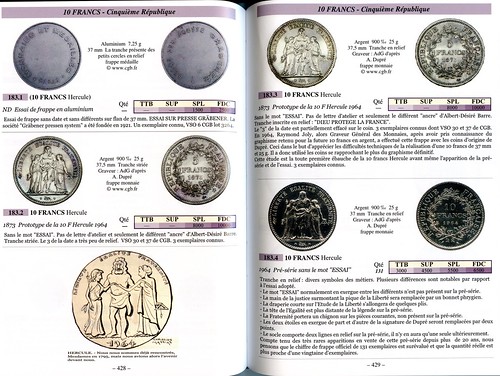
Bibliographical details:
Michel Taillard and Michel Arnaud, Essais Monétaires & Piéforts Français. Éditions Victor Gadoury, Monaco 2014 (1st edition). Hardcover. Thread stitching. 20.5 x 14.5 cm. 638 pages, all illustrations colored. ISBN 978-2-906602-43-4. 49 euros.
The book can be ordered directly at www.gadoury.com
Opinions about the book:
Pierre Rodier, General Engraver for the French Mints:
“At the end, I feel obliged to thank Editions Gadoury for insisting on publishing such a special catalog that reveals a highly extraordinary character. Please not that this is the first time that a compilation of numismatic art works has been achieved with such great a devotion to details. Hence, it has been more than desirable for this catalog to come into being. In my view, many numismatists and coin dealers will be smitten with this opus, crammed full of knowledge that was hitherto inaccessible to a broader public. I would like to share with you how happy I am to have made my humble contribution to this work.”
Hubert Lariviere, Chief Mint Engraver for Monnaie de Paris:
“I think that the just published book “Essais Monétaires & Piéforts Français” will provide an answer to any question you might have about the types of coins.”
To order, see: ESSAIS MONÉTAIRES & PIÉFORTS FRANÇAIS 1870-2001-ED. 2014 (www.gadoury.com/en/books/essais-monetaires-pieforts-francais-1870-2001-ed-2014)
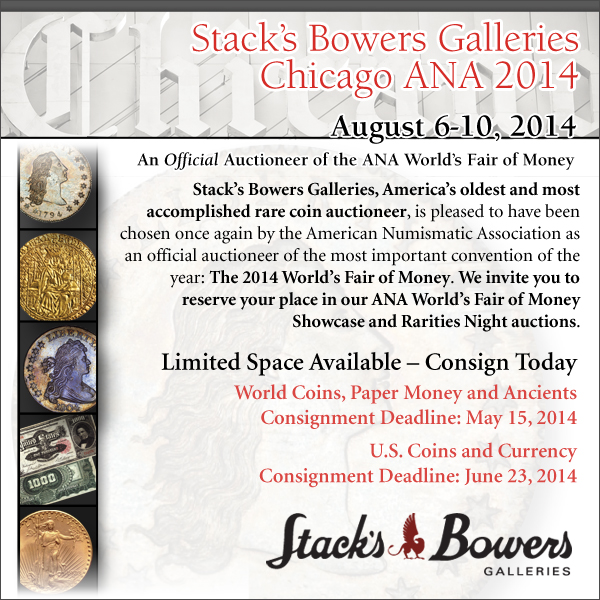
NEW BOOK: WOW! MORGAN DOLLAR DIE VARIETIES
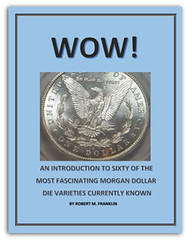 The “WOW” list is a group of sixty varieties of Morgan dollars that were originally put together for the beginning collector and contains coins that are easily identified.
The “WOW” list is a group of sixty varieties of Morgan dollars that were originally put together for the beginning collector and contains coins that are easily identified.
“I have only been into VAMs since around 2009 and I was pretty overwhelmed by all the ‘stuff’ there is to know,” said Robert M. Franklin, author of the new WOW set guide.
“My initial list was 40 coins,”
Franklin said. “When the number hit 60, I figured that was more than enough for anyone to chase after—let alone a beginner.
“I think one of the coolest things I took notice of as the set came together is that there are enough coins in it that are already on other list sets to give experienced guys a head start and maybe spark their interest in completing the set. They could discover some of the less well-known VAMs that are in there.“
In other words, the WOW set seems like the kind of set everyone can enjoy.”
Franklin‟s new book consists of 77 full color pages in a spiral bound 8.5” by 11” for- mat.
“It was,” he said, “designed for simplicity and ease of use, since one of the set goals is to draw new collectors.”
Many of the pictures used in the book are of the whole side of the coin, showing the viewer where to find the major pick-up-points. “This,” Franklin said, “ is to keep the perspective as close to ‘in hand’ as possible.”
The book sells for $25 and can be purchased from Franllin directly by email at wowvams@msn.com. The book is also available at www.vamsandmore.com.
To read the complete article, see: New Morgan Dollar Collectors’ Guide Published for the “WOW” List (www.coinweek.com/books-2/new-morgan-dollar-collectors-guide-published-wow-list/)
READERS REMEMBER MICHEL PRIEUR
Ian Marshall writes:
 I met Michel Prieur on my first visit to Paris in 1983. He was the manager of perhaps the shabbiest, messiest shop in the Bourse area where all the dealers in Paris are congregated. I did a little business as he had a considerable stock of bank notes. Only a few years passed before his family, I believe, purchased the business and began the transformation of it into one of the greatest numismatic firms in France.
I met Michel Prieur on my first visit to Paris in 1983. He was the manager of perhaps the shabbiest, messiest shop in the Bourse area where all the dealers in Paris are congregated. I did a little business as he had a considerable stock of bank notes. Only a few years passed before his family, I believe, purchased the business and began the transformation of it into one of the greatest numismatic firms in France.
Over the years they changed the shop on the bourse into a beautiful modern emporium for all things numismatic. They also purchased other locations down the street and turned them into further office space for their expanding enterprises.
As the internet age emerged they built a website, which I consider, should be a model for anyone who is in the numismatic trade. Michel was knowledgeable in many areas of numismatics and handled many great paper money collections in the French and French Colonial area.
He regularly came to the Maastricht Paper Money show in the early days and in the 80's and 90's I regularly visited him at the shop in Paris. Michel could be difficult, but was always fair and most professional in his business pursuits. France and the numismatic community at large has lost a giant. May he rest in peace!
He became known worldwide through his extensive website cgb.fr which was of such an importance to him that he changed the name of his company from Compagnie Générale de Bourse to cgb.fr. Michel Prieur was a pioneer of the internet who understood its implications at an early stage. In particular, borders between countries lost their meaning and this has changed the French coin market being a kind of isolated before deeply. Michel loved his internet site. February 26 this year he wrote to CoinsWeekly how proud he was of his website being not only available in French, English, Italian and German but also in Russian and Chinese. He raved of the funny look of his website featuring all these Chinese and Cyrillic characters.
Today, his website features some 350,000 pages with a shop, e-auctions, a comprehensive archive and a blog. Monthly the digital Bulletin numismatique offers news from the numismatic world. Currently cgb.fr employs 25 people who feel deeply obliged to their patron and his commitment to numismatics.
Michel Prieur was a great author. With the corpus of Syrian-Phoenician tetradrachms – written together with Karin Prieur – he has given us a reference book that will be quoted over the next decades in the auction catalogues. He developed the concept of ‘Le Franc’, a catalogue that can compete with the American ‘Red Books’ as for abundance of information. In 2014 the 10th edition of ‘Le Franc’ was published.
To read the complete article, see: Michel Prieur (1955-2014) (www.coinsweekly.com/en/News/4?&id=2682)
To read the earlier E-Sylum article, see: MICHEL PRIEUR 1955-2014 (www.coinbooks.org/esylum_v17n12a12.html)
THE BOOK BAZARRE
READERS REMEMBER LARRY LISOT
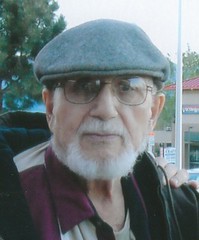 I would like to add a few words to David Lisot's moving tribute to his Dad Larry "Grizz" Lisot. I first met Grizz through by friendship with David in the early to mid-1970s. David was either in his last year in high school or early in his career as a student at CU in Boulder and would ride his motorcycle to my office in Denver where he would buy coins and we would swap stories. At one time he either brought Larry to the office with him, Larry came without him or one of them invited us to a "party" at the Lisot residence in Littleton.
I would like to add a few words to David Lisot's moving tribute to his Dad Larry "Grizz" Lisot. I first met Grizz through by friendship with David in the early to mid-1970s. David was either in his last year in high school or early in his career as a student at CU in Boulder and would ride his motorcycle to my office in Denver where he would buy coins and we would swap stories. At one time he either brought Larry to the office with him, Larry came without him or one of them invited us to a "party" at the Lisot residence in Littleton.
The parties were legendary. Larry and Dotty invited everybody and everyone; relatives, neighbors, friends, numismatic people, David fraternity brothers, Dan, Becky and perhaps even people off the street. The hospitality they exhibited was incredible, the food from Italian delicacies, to barbeque to steaks, seafood etc. was delicious and there was good wine and beer to enjoy.
Rita and I met many of the Lisot family from Larry's other kids, his older sister Becky and his brother Dan. I met Dotty Sue's sister (It may be Diane) and Cousin Bob with whom I had many political discussions. I believe I may have even met one or two of Larry's parents (or according to David perhaps his grand-parents).
And these weren't only parties for adults, kids of all ages attended, I learned to play (poorly) Bocce Ball and more than occasionally Grizz, David and I (and perhaps a few others) would sneak inside and look at a few goodies that David and/or Larry had recently purchased. Eventually both myself and Rita (and our children) became good friends with the entire Lisot family.
Grizz also was one of the founders and original members of one of the least known but most important numismatic organizations that I belonged to. Our group was named PANDA which stood for Poker and Numismatics in the Denver Area. At its height I think we met every other week but over the years as members moved, got old, or died it has eventually dissipated. Even our Poker table disappeared but over the years many of the most important numismatists in our area were participants including Bill Rosenblum, Chuck Mitton, George Lyons, Hal "Spike" Greiman, Dave Kolbe, William Early Wright, Jack Willis, Bob "Curly" Stanke, Victor England, David Donald and I'm sure even a few I have forgotten.
We mainly played poker, dealers choice and perhaps some crazy wild card games but not too many. I believe Grizz or "OL" another nickname he was called was the one who introduced us to the Booray, a Bayou gambling game. I forgive him for that. It was always a great evening (well almost always) and seldom did anyone win or lose more than $100 at one time. I also believe that Larry, along with yours truly, was an early member of another fun numismatic group, The Society of Bearded Numismatists known affectionately as the SOBs
I could go on and one with my thoughts and feelings about Larry (and all the Lisots for that matter) but I'll had a few "Larry Stories". In the early 1980's Rita and I were invited to a party at David's house in Boulder for his 30th birthday. We knocked at the door and were greeted by a young lady who said, ""Oh hi, you must be Larry, David's father. At the time I was about 38, and Grizz was in his mid-50s. But she had heard that Larry had a beard. I had a beard also and to a girl in her 20's, I looked old. My beard came off the next day.
Larry was a collector extraordinaire and he loved quality in both his world banknotes and cigar labels (and his other "interests as well" I am sure). I remember a sad time in his numismatic business career when he sold a number of high quality better world notes to another dealer. The dealer, a mutual "good" friend in the business wrote a check to Larry ( $5K+) figure and then said, "oops wrong account", let me give you one from my business account. He then tore up the check and wrote another from a different account and of course the check bounced.
As far as I know the other guy never made good on it. I'm not going to mention his name but his guy could have been the most successful world paper money dealer in the US. At that time he was among the best known, he was friendly, gregarious, incredibly knowledgeable about the field and seemingly honest. Unfortunately he was living beyond his means, wanted to buy every nice and spending too much of his money on powder to put up his nose and if recollect correctly on woman who weren't his wife. Not a smart move because the woman that was his wife was just about to finish getting her law degree. And he never called to apologize or try to pay his debt. Larry was terribly hurt, not just financially but of course the other dealer was considered a good friend.
But I'm sure Larry would have said that the good in our hobby outweighed the bad because was always such a positive person. The last time Rita and I saw him was probably about ten or more years ago when he and Dotty were driving up to Colorado perhaps to visit friends and relatives but also to drive through the tiny town of Aguilar in southern Colorado.
Larry pulled into our dirt driveway from our dirt road in a huge Cadillac - certainly not a mountain car. But Larry said that when he moved from Aguilar to go to school in Boulder he told himself that he would someday return to Aguilar driving the biggest Cadillac in the world slowly down the street (there's not much money in Aguilar) waving at everybody he saw. He did that but said he didn't recognize anyone and probably nobody recognized him.
Larry's health was just beginning to deteriorate at that time and while we talked that we would see him soon we never did. Boy, I wished we had made the effort.
My last story gives a clue to Larry's sense of humor. Larry, Spike Greiman, Bill Wright and I (I think it was that group) were flying to a show in the mid-west (I think Milwaukee). Our flight was scheduled to leave early in the morning (no later than 6 so we car-pooled or met at the airport at some ungodly hour. We got to the airport, checked in to our flight than headed to the nearest fast food place to have coffee and some breakfast.
Larry, Spike and I were dressed very causally and considering the time of the day, very disheveled with perhaps some (or all) mis-matched clothing. However Bill Wright was dressed in a suit and looked like he was going to attend the local Chamber of Commerce meeting. It was then that Grizz decided that only the FBI, Secret Service or some similar organization would wear something like that at 5 AM. We decided that Bill Wright was a CIA agent. Is it a coincidence that within a year or so Bill started to have financial problems and left town in the middle of the night. Was it because his cover was blown?
However it was just two weeks ago when Rita and I were beginning our spring road-trip. While we didn't stop there, we did wave and reflect how lucky we were to have Larry as a friend. We've all heard stories about so and so was or is a better person that he is a player. Well for Larry he was a good business person, a successful Chemical Engineer, a fantastic family man but above all he was a great man. All of us that had the opportunity to know Larry, know how lucky we were to have the good fortune to know him and to be his friend.
We miss you terribly but thanks for sharing your life with us and making us virtual Lisot family members. "Grizz, I will make sure that PANDA" will reconvene at least once in the coming months for at least more poker/booray night.
Ian Marshall adds:
In my early days in the paper money field, Larry was a colleague and a friend. We shared a true love of paper money and particularly in those early years beautiful African notes. Larry was a fixture at the early Memphis Paper Money shows and we always talked and did some business.
Larry was involved, then, in the mining industry and, I think, traveled greatly. He drifted away from the mainstream of numismatics and except for one visit to Memphis some years ago, I have not seen Larry in many years. I would always make a point of asking his son David, when I saw him in my numismatic travels, how Larry was doing. Another one of the early paper money pioneers has passed. May he rest in peace!
To read the earlier E-Sylum article, see: OLIVER LAWRENCE LISOT 1927-2013 (www.coinbooks.org/esylum_v17n12a13.html)
READERS REMEMBER LOUIS HUDSON
Ian Marshall writes:
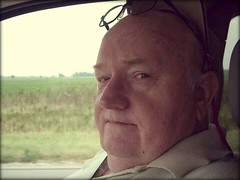 I first did business with Louis Hudson soon after I entered the numismatic field in the late 1970's and first met him at my first Memphis International Paper Money show in 1979. Louis was always first and foremost a friend. He also was the primary source for many years of all paper money of Latin America. He always brought back wonderful things from his regular trips to South & Central America.
I first did business with Louis Hudson soon after I entered the numismatic field in the late 1970's and first met him at my first Memphis International Paper Money show in 1979. Louis was always first and foremost a friend. He also was the primary source for many years of all paper money of Latin America. He always brought back wonderful things from his regular trips to South & Central America.
I always bought wonderful notes from Louis and he always managed to relieve me of any rare Latin American items that I had managed to find. Over many years until his decline in health in the early part of this century I saw Louis regularly and shared many laughs and numismatic stories, and isn't that what makes numismatics such a treasure for us all? I also learned from Louis as I did from so many numismatic veterans, in my early years in business. Louis was a true numismatic giant and will be missed by all who collect and loved Latin American numismatics as he did!
To read the earlier E-Sylum article, see: REMEMBERING LOUIS HUDSON (www.coinbooks.org/esylum_v17n11a04.html)

NOTES FROM E-SYLUM READERS: MARCH 30, 2014
Still More Bald People on Coins
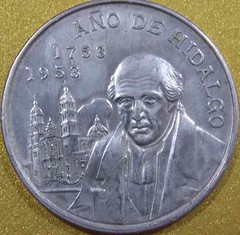 Juan Carlos Harris of
Mexico City writes:
Juan Carlos Harris of
Mexico City writes:
Regarding bald people on coins, in Mexico, many coins bear the image of Miguel Hidalgo, one of Mexico's forefathers, who was a bald priest.
To read the earlier E-Sylum article, see:
NOTES FROM E-SYLUM READERS: MARCH 23, 2014 : More Bald People on Coins
(www.coinbooks.org/esylum_v17n12a15.html)
The Penny Police and the Sphinx Bob Van Arsdell writes:
I bet the PC Penny Police think nothing of spending "two bucks" for a cup of coffee. Please - write something about numismatics we DON'T know - like why they put the Sphinx on the obverse of that gold bicentennial medal in the Lyn Knight sale?

Chip Howell writes:
I noted that even the U.S. Mint is now using the term "penny" - I saw it on a brochure, AND it appears in their description of the 2014 Proof Set... WE know the difference, but I think the battle is lost...
"There are no design changes to the half-dollar, dime, nickel, or penny."
To read the complete product description (scroll to the bottom to see the penny reference) see:
2014 United States Mint Proof Set® (P16)
(catalog.usmint.gov/webapp/wcs/stores/servlet/ProductDisplay?
catalogId=10001&storeId=10001&productId=17400&langId=-
1&parent_category_rn=10211)
To read the earlier E-Sylum articles, see:
NOTES FROM E-SYLUM READERS: MARCH 23, 2014 : Turning Cents Into Pennies
(www.coinbooks.org/esylum_v17n12a15.html)
NOTES FROM E-SYLUM READERS: MARCH 23, 2014 : A Gold Bicentennial Token
(www.coinbooks.org/esylum_v17n12a15.html)
Fred Reed Address Mitch Ernst of the Central States Numismatic Society wrote that numismatic researcher and author Fred Reed is still sidelined. Mitch and I encourage E-Sylum readers to continue sending him their cards and good wishes. As published previously, Fred's address is P.O. Box 572022, Dallas, TX 75357.
To read the earlier E-Sylum article, see: AUTHOR FRED REED SIDELINED BY ILLNESS (www.coinbooks.org/esylum_v17n04a03.html)
Photo: John Huffman and Barry Tayman Scott Miller writes:
In light of the few photos available of John Huffman, I am attaching a photo of John (seated) along with Barry Tayman, courtesy of Gordon Frost’s wife, Rosalie
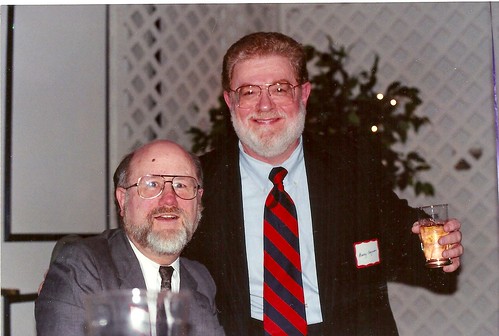
John Huffman, Barry Tayman
To read the earlier E-Sylum article, see: JOHN HUFFMAN AT THE INVASION OF LOUISVILLE (www.coinbooks.org/esylum_v17n12a25.html)
Australia's First Bank Note Sells

Australia's first ever bank note has been sold for AUD$280,000 (U.S. $260,000) at an auction house in Sydney, Australia.
The almost 200-year old 10 shilling note - the equivalent of about 80 U.S. cents today - was sold at auction house Noble Numismatics in Sydney, Australia.
To read the complete article, see: Australia’s first bank note sold for $260,000 (www.cnbc.com/id/101530167)
QUERY: EARLIEST SALE OF U.S. NUMISMATIC AUCTION CATALOGS SOUGHT
Jim Glickman writes:
 I just purchased a catalog of Coins and Medals by Henry Cook of Boston (in conjunction with Leonard & Co.) dated May 23-24, 1866. Pages
19-20 of this catalog lists a small number of numismatic catalogs, including the 'Finotti Collection of Coins and Medals" (Lot 462), a grouping of six catalogs including the Levick sale (Lot 466), the October 1863 Woodward's Sale (Lot 468), "Catalogue of Cogan's United
States Cents...Philadelphia 1858; rare" (Lot 469), and a few others.
I just purchased a catalog of Coins and Medals by Henry Cook of Boston (in conjunction with Leonard & Co.) dated May 23-24, 1866. Pages
19-20 of this catalog lists a small number of numismatic catalogs, including the 'Finotti Collection of Coins and Medals" (Lot 462), a grouping of six catalogs including the Levick sale (Lot 466), the October 1863 Woodward's Sale (Lot 468), "Catalogue of Cogan's United
States Cents...Philadelphia 1858; rare" (Lot 469), and a few others.
Being a comparatively new collector of early U.S. numismatic literature, I hadn't realized that as early as 1866 numismatic catalogs were sought after and actively bought and sold. Moreover, at this early date dealers apparently had a sense of which catalogs were "rare." My question is: what is the earliest known offering of U.S. numismatic catalogs for sale? I can't imagine it would be too much earlier than May 1866.
QUERY: BUSHNELL'S NUMISMATIC NOTES SOUGHT
Randy Clark writes:
I was recently asked of the whereabouts of Charles I. Bushnell's "Numismatic Notes in manuscript" as referenced by Sylvester Crosby in his Early Coins of America. I see the same question was published by the Colonial Newsletter in April 1973 as technical note RF-47 and in September 1974 Charles Funk posted a reply as RF-47A, but was unable to identify where the manuscript was. In the 1995 American Numismatic Society Coinages of the Americas Conference, Phlip Mossman referred to "... the handwritten numismatic notes of Charlies I. Bushnell of New York, which Crosby quoted and which are lost."
Has anyone ever located the Charles Bushnell handwritten numismatic notes related to colonial and confederation era coinages? There is a handwritten Bushnell notebook in the ANS manuscript library, but it addresses a time period mostly in the 17th century, and possibly may be part of a series of manuscripts written by Bushnell on early numismatics.
The chief point that I want to make here is to suggest that someone look into the library of the New York Historical Society. Since the manuscript is not in ANS, this would seem to be a likely alternative repository for it.
But further, Bushnell's coins were sold at auction, by the Chapman brothers, soon after his death. I have been able to examine the catalog of the sale, and can report (in case this is not known to the inquirer) that the sale included 3000 lots, of which 2847 lots were of coins and related artifacts, 152 lots were of books and catalogs that made up his numismatic library, and the one remaining lot was his coin cabinet. None of the 152 lots of library material included his manuscript.
Still further, Bushnell's historical library was also sold at auction, by the Messrs. Bangs & Co. I have not seen the catalog of this auction, but I have seen the entry for the catalog in the National Union Catalog, and can report that its title is: Catalogue of the library, etc., of the late Charles Ira Bushnell, to be sold at auction Monday April 2d and four following days, by Messrs. Bangs & amp; Co. It contains 286 pages, and there were 3,452 lots in the sale. Copies of this catalog are reportedly held in: Library of Congress, Philadelphia Union Library, Duke University Library, Cornell University Library, American Philosophical Society Library (Phila.), University of Michigan library and the University of Virginia Library. Possibly a reader nearby one of these sources can check the catalog to see whether or not the missing manuscript was among the items in this sale.
Then the problem will resolve itself into locating the buyer!
THE BOOK BAZARRE
MORE ON THE ROYAL MINT'S PROCESS
Ed writes:
According to a two minute BBC video iSIS is a special material that can be added to the aRMour process which electroplates a 25 micro coating on coin blanks.
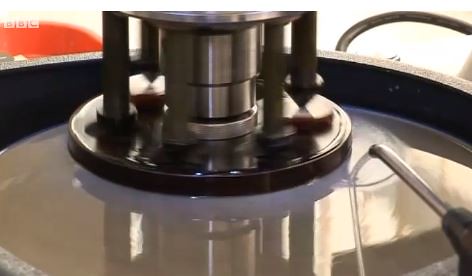
To view the video, see: Royal Mint designs 'unique' property to beat fake coins (www.bbc.com/news/uk-wales-26125297)
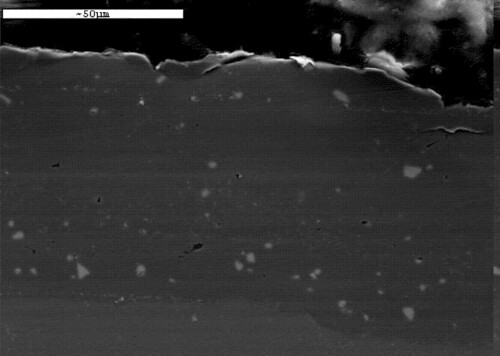
Ed adds:
Adam Davis suggested on Stack Exchange that the coating is luminescent particles, as described in a 2011 patent by Authentix, Inc.
Figure 3 of that patent shows a picture of randomly deposited particles phosphorizing. I speculate that the 'simple iSIS' detector merely checks for the existence of particles. The 'advanced iSIS' might record the shape and position of the particles. The shape and position of randomly deposited particles could be treated as a 'fingerprint' until wear causes the exposed particles to fall off and new ones to be exposed. In this way individual coins could be traced like a serial number, although it would be expensive and time-consuming to do so.
To read the complete Stack Exchange article, see: How does the authentication in the new UK £1 coin work? (security.stackexchange.com/questions/53673/how-does-the-authentication-in-the-new-uk-1-coin-work)
To read the complete patent, see: Metallic materials with embedded luminescent particles (www.google.com/patents/US20110305919)
To read the earlier E-Sylum article, see: THE ROYAL MINT'S ISIS ANTI-COUNTERFEITING SYSTEM (www.coinbooks.org/esylum_v17n12a21.html)
BASEBALL HALL OF FAME COMMEMORATIVE LAUNCHED
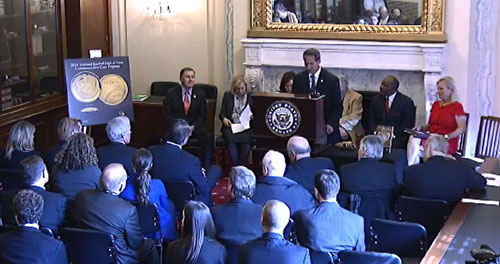
To read the complete article, see: 2014 National Baseball Hall of Fame Commemorative Coins (news.coinupdate.com/national-baseball-hall-of-fame-commemorative-coins-3211/)
David Lisot interviewed the young man who purchased the first baseball coin at Baltimore show. Here's a photo of him from the U.S. Mint:
Cole Bank, a 12 year old from Vienna, Va., holds his 2014 Baseball Hall of Fame Commemorative Coin March 27 at the Whitman Coin and Collectible Spring Expo at the Baltimore Convention Center in Baltimore, Md. United States Mint photo by Lateefah Simms.

Cole Bank
To view the video, see: Young Collector Buys First Baseball Commemorative Coin. VIDEO: 2:01 (www.coinweek.com/featured-news/young-collector-buys-first-baseball-commemorative-coin-video-201/)
LARGE HEAD OBVERSE WASS, MOLITOR$20 GOLD PIECE OFFERED


Advanced collectors of Territorial gold coinage will have a once-in-a-lifetime chance to acquire a newly discovered variety - an entirely unique example of an 1855 Wass, Molitor & Co. $20 gold piece, AU53>, known as the Large Head Obverse, offered by Heritage auctions from The Riverboat Collection in the official auction of the Central States Numismatic Society Convention (CSNS) April 23-25, 2014 in Chicago.
"The 1855 Wass, Molitor & Co. $20 gold with the Large Head obverse is one of the most elusive issues in the Territorial gold series," said Greg Rohan, President of Heritage Auctions. "This coin, from the celebrated Riverboat Collection, has recently been examined by several expert numismatists and some exciting new findings have come to light."
Until now it was believed that all four surviving examples of this Large Head variety shared the same obverse and reverse. Careful study of the images of the Riverboat coin on the Heritage website by numismatic researcher Wayne Burt indicated otherwise. Further investigation by Burt, Saul Teichman, Stuart Levine, and Heritage cataloger David Stone revealed that the Riverboat specimen features the same Large Head obverse as the K-8 coins, but the reverse exhibits the design used on the Wass, Molitor Small Head $20, K-7. Information from bibliophile Dan Hamelberg proved essential in this research.
The two reverse designs are easy to differentiate, as the eagle's left (facing) wingtip points to the "R" in "FRANCISCO" on the K-7 reverse, while the wingtip points to the "F" on the K-8 reverse. The Riverboat specimen is the only known example of this newly discovered Territorial gold variety.
"The coin in the Riverboat Collection represents an entirely different variety from the coin pictured in Donald Kagin's Private Gold Coins and Patterns of the United States," said Rohan, "and the recent study indicates the coin is almost certainly unique. Ken Bressett informs us that this discovery is under consideration and is a good candidate for inclusion in the Red Book."
The 1855 Wass, Molitor & Co. $20 pieces were originally produced to provide much-needed circulating coinage during a period when the San Francisco Mint found it impossible to produce gold coins because of a shortage of parting acids.
Both Large and Small Head varieties were struck in large numbers. The coins were well-received by the public and circulated widely for a time, but the great majority of the coins were turned in to the San Francisco Mint and melted when that facility resumed gold coinage on a large scale. Like most other Territorial gold issues, the Wass, Molitor twenty dollar pieces were rarely encountered as early as 1860.
The Riverboat specimen was probably the first Wass, Molitor Large Head $20 to appear at auction, in a Chapman sale in 1896. It was definitely the last example to be publicly offered when it appeared in Stack's Amon G. Carter, Jr. Family Collection in 1984, more than 30 years ago.
To view the auction lot preview, see: 1855 $20 Wass Molitor Twenty Dollar, Large Head AU53 NGC (coins.ha.com/c/item.zx?saleNo=1204&lotIdNo=14006)

Archives International Auctions, Part XVIII
Chinese and Asian Banknotes, Coin & Scripophily including additional properties from various consignors
Highlights include:
- Lot 1870. Hupeh Government Mint, 1899 Issue
- Lot 1904 Hong Kong, Chartered Bank of India, Australia & China, 1934, $50, P-56
- Lot 1551 Board of Commissioners of Currency ND 1976 $100 Specime
- Lot 1683 China, Bank of Communications, 1941, 500 Yuan, P-163a, SM126-263 F
- Lot 1806 International Banking Corporation, 1919 Tael Issue Specimen
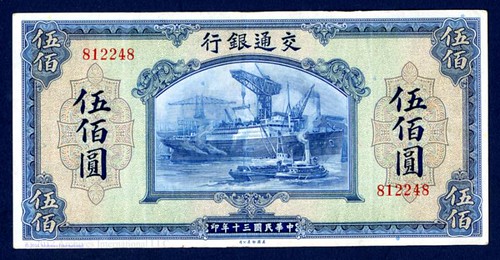
1580 Lemoine Avenue, Suite #7
Fort Lee, NJ 07024
Phone: 201-944-4800
Email: info@archivesinternational.com
WWW.ARCHIVESINTERNATIONAL.COM
QUERY: FENIAN BROTHERHOOD MEDAL INFORMATION SOUGHT
Anne E. Bentley, Curator of Art & Artifacts at the Massachusetts Historical Society writes:
We received the following enquiry about a neat little item-perhaps one of our readers can help identify this piece?
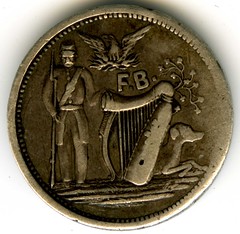
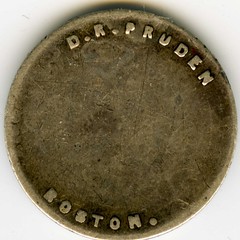
Her correspondent wrote:
I am seeking background information on the dime-sized, silver Massachusetts medallion pictured in the attached image files.
I have shown the item to a number of experienced Massachusetts coin dealers. None have previously encountered or heard of the item.
Given the elements of the design, there is little doubt about the nature of the item, but historical background about the precise purpose is elusive ("reminder" of affiliation, secret pass token, ???).
The medal was found in Eastern Maine several years ago. Given the aborted Fenian attack on New Brunswick which was staged in the Lubeck-Calais area in 1866, its being found in Washington County, Maine is not surprising.
Any insight which you or your staff might be able to offer would be most appreciated.
Anne adds:
In 1863 a D.R. Pruden of West Meriden CT with colleague C.A. Wellington of Boston, applied for U.S. Patent 32,850 “Improvement in ornamenting Hollow articles in Metal.” In 1871 a D.R. Pruden was listed in Boston as Stencil Cutter. I have no idea if these are the same D.R. or even connected to the medal pictured.
To view the Smithsonian Fenian Brotherhood Medal, see: Fenian Brotherhood Medal (americanhistory.si.edu/collections/search/object/nmah_1382531)
To read the complete article, see: The Fenian Brotherhood Token of 1866 (www.novanumismatics.com/numismatics-american-politics/the-fenian-brotherhood-token-of-1866/)
QUERY: ENGRAVED CONFEDERATE CAMP MARION COIN INFO SOUGHT
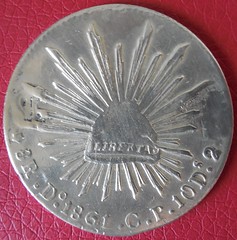
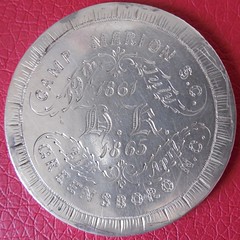
I'm trying to get some information about a coin that my great-grandfather obtained after his S.C. confederate unit surrendered in 1865. Photos of the coin are attached. It belongs to a family member, a private owner in Georgetown, S.C.
There have been some stories passed down about his receiving this coin at the time his unit surrendered. But it looks to me as though he may have obtained it after the end of the war and had it engraved at some point. From looking on-line, I see where other similar coins were issued and hand-engraved. Can you point me to anyone who could tell me something about them: who issued them? when and where were they generally made? how did the soldiers obtain them? etc.
This information is in a book published by Robert M. Dunkerly titled "The Confederate Surrender at Greensboro", published in 2013 by McFarland & Co., Inc. In the book, Dunkerly describes the last days of the Army of Tennessee which surrendered in disarray in April, 1865 while encamped in different locations in North Carolina, including Greensboro where my great grandfather's unit, The S.C. 10th Regiment, was bivouacked.
Confederate General Johnston had assumed command of this army and announced on April 26th 1865 that he had surrendered to Union General Sherman. Just prior to the surrender, Confederate President Jeff Davis had directed General Johnston to send $37,680 in Mexican silver coins to Charlotte where Davis was then located. In an act of "defiance," General Johnston decided to distribute this coinage to the 32,174 men under his command to be used for "forage" on their way home. The dollar amount assigned to each coin apparently varied between $1.10 to $1.80.
As Dunkerly states, "The differing amounts (of value) are hard to reconcile. This may be the result of a faulty distribution system, stealing, different distribution systems, or simply failing memories of those who wrote about the event. As the money went out to widely spread out commands, officers of the various units chose to distribute it differently." (p. 131-32)
The book recounts various stories from some of the men who received the money, all of whom stated it was the most money they had seen "in a long while." As Dunkerly recounts, "This pitiful amount was the only payment received for months and was the first coin seen by many of the men during the war." Some of the men wrote later that they immediately spent the money in their effort to get home, but others decided to hold onto this payment as a treasured object.
The book contains an excerpt from Confederate Captain Stoney's diary: "The brigade was paid today one dollar and a quarter in silver per man, the last I suppose of the Confederate treasury. I shall have mine made into a medal to keep and value as received from the dying hands of my government. It is the greatest earthly satisfaction, and only consolation now, that I entered her service on the day of the inauguration of this war; was never absent from my command except by authority or wounds, and continued in the field until the last day."
My great grandfather must have fallen into this latter category, hanging onto this "payment" from the Confederate treasury as a reminder and memento. I think he was very respectful of that coin and what it represented. In my great grandfather's 1909 obituary, it states: "He continued with his command until the surrender in Greensboro, N.C. in 1865. When the army was disbanded his pay amounted to $1.10 in silver and with this sum as his cash capital he started for home to begin again his business and life."
Apparently, like Captain Stoney, many of the men who kept the coin had it subsequently engraved in the form of a medal. I found an image of a very similar coin on the E-Sylum website from a 2011 posting where the engraving on the coin is very different. So I suspect very few of the surviving coins are alike, having been engraved at different locations with different markings according to the owner's wishes.
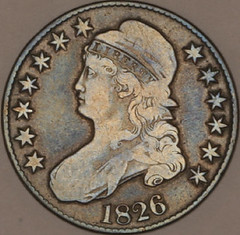
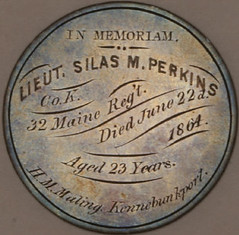
1864 Engraved coin from The E-Sylum
At any rate, this account is in line with the oral tradition regarding this coin's provenance. I am glad to see it confirmed in a well-researched account of those last chaotic days of the Civil War. One could gather from Dunkerly's account that at least 32,000 of these coins were distributed in April, 1865. I wonder how many still survive?
With regard to the coin itself, I was trying to determine what the markings on the back meant. It apparently is a Mexican Reales 8 silver coin. This is what Wickipedia says about it:
"With the adoption of the 1824 republican constitution, the United Mexican States began issuing coins. There were silver ½, 1, 2, 4 and 8 reales, and gold ½, 1, 2, 4 and 8 escudos, with silver ¼ reales added in 1842. Copper coins for1⁄16, ⅛ and ¼ real were issued both by the Federal government at the Mexico City mint and by the state governments at various mints around the country.
On the republic's coins, the Mexican eagle moved to the obverse, with the legend "República Mexicana". The reverse featured a liberty cap with rays behind. The legend on the reverse reads "-denomination- -mintmark- -date- -assayer's initials- 10 Ds. 20 Gs." Mexico used the medieval system of dineros and granos to measure the fineness of their coins, twelve dineros designating pure silver with each dinero divided into 24 granos. A coin of 10 Ds. 20 Gs equated to .902777 fine.
The brief reign of Maximillian (1864–67) interrupted the production of republic type coins and many of the denominations ceased production either in 1863 or by 1870, as the decimal currency based on the peso was introduced. However, 8 reales coins continued in production until 1897."
This explains what is on the back of my great grandfather's coin. It was a Mexican 8 Reales 10 dineros 20 granos, with the denomination, mintmark, date, and assayer's initials denoted.
To read the earlier E-Sylum article, see: EXHIBIT: HAND-ENGRAVED CIVIL WAR SILVER COINS (www.coinbooks.org/esylum_v14n01a14.html)
QUERY: GEORGE H. EARLE, JR COLLECTION
 Attached are the front and back of a black-and-white photograph I purchased recently on eBay. The notation on the back of the image tells the story. The loose (?) coins being placed into the safe deposit box were recovered in 1939 following a theft from the Pennsylvania Academy of Fine Arts in 1938.
Attached are the front and back of a black-and-white photograph I purchased recently on eBay. The notation on the back of the image tells the story. The loose (?) coins being placed into the safe deposit box were recovered in 1939 following a theft from the Pennsylvania Academy of Fine Arts in 1938.
The coins were part of a collection once owned by George H. Earle, Jr., who must have donated them to the Academy at some point. Might I inquire of your readers if anyone knows of this theft or the donation, and is this the same George Earle whose collection was sold by Henry Chapman in 1912?
I took a close look at the image with a magnifying glass in hopes of identifying any of the coins, but not enough details are visible. I swear the guy on the right is Humphrey Bogart!

MEDAL & TOKEN MAKER SCHWAAB OF MILWAUKEE
MILWAUKEE’S SCHWAAB STILL IN BUSINESS
BUT NO LONGER MAKING MEDALS &pam TOKENS
The Milwaukee Journal Sentinel carried an article this week on a local institution, the Schwaab Stamp and Seal Company. This firm has a strong association with numismatics, albeit nothing recent. It exemplifies the American spirit to exist, continuing in business despite societal changes in customs and products.
While Schwaab is noted for its primary product, rubber stamps, hardly a space-age product, its product line was widespread in the 19th century as it is today in the 21st century. Early on it manufactured stencils, even calling itself Schwaab Stamp and Stencil Co. for a time. Victorian business used these products far more than we do today. But if that’s what you need today Schwaab can make it for you.
Branching out to other products, perhaps because it can produce these with the equipment on hand, Schwaab made tokens, badges, medals, watchfobs and seals of numismatic interest. The firm possessed presses and die making equipment that allowed them to stamp such simple diestruck items.
It is legion that American tokens of the 19th century were made by these stamp and stencil firms, usually local one and two-man shops. Mostly lettering without pictorial images; such tokens are easy to produce with this industry’s tools and tooling.
Notably Schwaab made a type of badge different from all others that collectors call a “stamp and stencil medal.” It is uniface, struck on sheet brass, often of an unusual shape and without any patina. Such light-weight, shell-like items are easily stamped on drop-hammer presses in comparison to solid medals struck in sturdier presses.
A series of these stamp and stencil badges were made for the Columbian Exposition of 1892-3 for delegates to the expo from individual states. The Smithsonian Institution has a nearly complete set of these in its numismatic collection.
The entry on Schwaab in my databank of numismatic producers lists 1892 as one of their earliest products and the founder of the company was Andrew Schwaab, for whom the company was named. I fanaticized Andy Schwaab came to America that year to start his business because of the great opportunity spawned by the Columbian Expo. Thousands of medals were made for this world famous event that attracted medal makers to come to America.
My fantasy was squelched when I read in the Journal’s article that Schwaab states it has been in business for 133 years, making their founding date 1881. Andy was busy long before the Columbian Expo.
Among Schwaab’s numismatic creations of the past are:
- Perhaps most important to numismatists is the fact Schwaab made the convention badges for the American Numismatic Association in 1950 and 1951.
- So-Called dollar collectors will realize Schwaab Stamp as the origin of the Schwaab Dollars for the 1894 California Midwinter Expo.with three different reverses (HK 254-257).
- Schwaab was the convention medal maker for the GAR with a run of years at the turn of the century
- For the soldiers going off to World War I Schwaab made a good luck token, perhaps with the intent of a safe return after the War.
Schwaab’s customers in the early 20th century were located throughout America. Their badges and medals honored anniversaries, inaugurations, reunions, encampments, dedications and other events. However I have no record of any such numismatic item after 1932.
Today Schwaab has five plants as a maker – in addition to stamps, stencils and seals -- of embossers, name badges, pet tags, price marking guns, magnets, signs, ashtrays, door knockers and other products.
Interesting that tokens and medals had a part in the early history of a firm that has developed as a maker of a smorgasbord of American products in the present era.
To read the complete article, see: Old rubber-stamp maker Schwaab still making its mark (www.rep-am.com/articles/2014/03/29/lifestyle/technology/793814.txt)
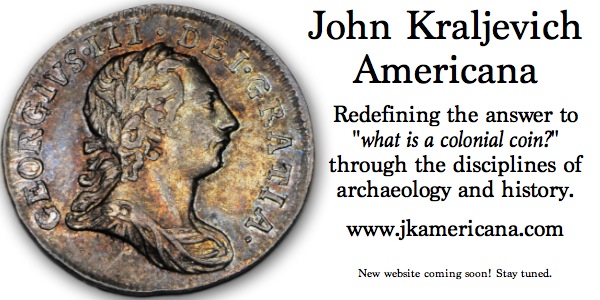
REVIEW: THE KÜNKER SPRING 2014 SALES
Künker Spring Sale: A Week Full of Surprises
140.000 euros for a Chinese dollar from 1896, 110.000 euros for a gold coin from Czechoslovakia from 1938 – the spring sale of Künker was full of surprises! Less surprising was: the pre-sale estimate of 5.7 million euros was easily surpassed by the hammer price amounting to 8.75 million euros.
The spring auction of Künker / Osnabrück took five days. The four weighty catalogs contained many an interesting special collection. Hence, several hundreds of dealers and collectors came to the Hotel Steigenberger Remarque to witness the 6,129 lots on offer changing hands.
Auction sale 245 – Gold coins / German Empire coins since 1871 / Russian coins
The most remarkable result of day one was obtained by a 5 ducat piece from Czechoslovakia from 1938 of which just 56 specimens were produced. Its obverse shows the national coat of arms as well as a lime tree branch, on the reverse Saint Wenceslas with the lettering Hedej Zahynouti Nam i Budoucim (= Do not let us or our descendants perish). Its pre-sale estimate had been 10,000 euros, and it can be found for 30,000 euros in the latest World Coin Catalog written by Schön. That the two prices are totally out of date is evidenced by the hammer price: 110,000 euros!
The impressive results obtained by other gold coins, like the gold medal of Rudolf II on the seizure of the fortress of Gran in 1595, somewhat took the back seat. The good very fine piece rose from its estimate of 3,000 euros to 15,000 euros hammer price. Even higher was the price obtained by a Saxon 12 ducat piece from 1678 on the conferral of the Order of the Garter. The extremely fine rarity yielded 26,000 euros (estimate: 10,000 euros).
A collector was willing to pay 55,000 euros for the rare 20 mark piece from 1875 of Henry XXII of the Elder Line of Reuss. It therewith became the most expensive coin of the section German Empire.
The most expensive Russian coin was sold for 85,000 euros. It was an extremely fine gold medal of 10 ducats on the coronation of Paul I (1796-1801) in Moscow with a pre-sale estimate of 40,000 euros.
Auction sale 246 – Coins and medals from medieval to modern times
Catalog 246 comprising many special collections was next. In the afternoon of 11 March 2014 the special collection Malta was auctioned off that brought more than two times its estimate in the end. This is not the place to elaborate on every single spectacular result, so the three bestsellers will have to suffice: Ramon Perellos y Roccaful (1697-1720), 2 zecchini, n. d., Valletta (about VF, only two specimens available on the market, 10,000 euros / 24,000 euros); Martin Garzes (1595-1601), 4 tari n. d., Valletta (EF, 2nd known specimen, 10,000 euros / 19,000 euros); Pierino del Ponte (1534-1535), zecchino n. d., Birgu or Fort St. Angelo (traces of mounting, VF, 6th known specimen, 3,000 euros / 16,000 euros).
An even higher total result with more remarkable hammer prices was achieved by the Chinese collection. The total results added up to three times the original estimate.
The top seller was a dollar from Pei-Yang Province, graded MS 62 by NGC – which corresponds to the European grading extremely fine to mint state and that made the piece, rare as it is already, even rarer. The dollar from 1896 came with a rather modest estimate of 15,000 euros to rise to incredible 140,000 euros in the end!
Equally surprising at least was the result of a set of commemorative coins of The People’s Republic of China from 1990, ‘Dragon and Phoenix’. The material value had already been about 22,000 euros but the estimate of 30,000 was exceeded by far by the hammer price amounting to 80,000 euros which evidences that the Chinese people cherish their present coins just like their ancient ones. 38,000 euros still were obtained by a pattern of a dollar from Fengtien Province that was being produced by Schuler Company in 1897 and never issued (EF, 5,000 euros / 38,000 euros).
Comparatively modest were the results of the important Mansfeld Collection that was auctioned off on 12 March 2014. The most expensive coin was an extremely rare and extremely fine reichsthaler from 1710, minted in Eisleben on the death of John George III (3,000 euros / 11,000 euros).
Auction sale 247 – 500 Years of history and art as reflected in the medal. The Georg Baums Collection
Another highlight of the spring auction was the Baums Collection that was offered for sale on 13 March 2014. The collector had assembled a whole number of intriguing pieces that attracted wide interest. Whereas the pre-sale estimate had been 1.3 million euros, the hammer prices reached the total of 1.8 million euros. Telling examples for the high hammer prices are the gorgeous, about extremely fine gold medal of the city of Danzig in the weight of 16 ducats from 1646 on the wedding of Wladyslaw IV with Marie Louise Gonzaga (20,000 euros / 42,000 euros) or a perfect Russian silver medal of Peter the Great on the Treaty of Nystad that probably was made in later times, during the 19th century, using the dies from 1721 (2,500 euros / 11,000 euros). As it was expected, the most expensive item of the Baums Collection was the magnificent Trinity Medal by Hans Reinhart (40,000 euros / 46,000 euros).
Collectors were given the opportunity to place their bid in the lower price regions as well. Many pieces ranged in the two- and three-figure regions, like for example a very interesting gilded bronze medal on philosopher and writer Jean-Jacques Rousseau. It came with an estimate of 75 euros but changed hands in the end for just 60 euros!
Auction sale 248 – Ancient coins
Friday was entirely devoted to ancient coins. Some very good results were to be witnessed with Greek coins. A very rare tetradrachm from Akragas with the two eagles gorging a hare had been estimated at 25,000 euros, to achieve a hammer price of 32,000 euros. Two dekadrachms from Syracuse were available for sale, the first – signed by Euainetos, preserved better than very fine – obtained 20,000 euros (12,500 euros), the second one – without signature – 16,000 euros (10,000 euros).
Roman aurei being in particularly high demand with collectors at present was evidenced by the auction sale’s second part. A good very fine aureus of Octavian from 43 B. C., formerly part of the collections Prowe and Huntington, rose from its estimate of 12,500 euros to 19,000 euros, a very fine aureus of Caligula with the head of Divus Augustus on its reverse rose from 10,000 euros to 26,000 euros and an extremely fine aureus of Vespasian from 15,000 euros to 34,000 euros. The section’s most expensive coin was a likewise extremely fine aureus, dating to 82/3, showing the portrait of Domitia on its obverse and a peacock on its reverse (30,000 euros / 65,000 euros).
All results can be found on the website of Künker at www.kuenker.de . There you will also find a list of unsold lots available for sale at 80 % of their estimate.
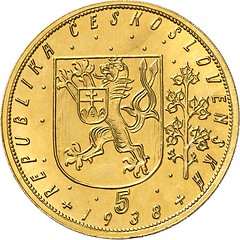
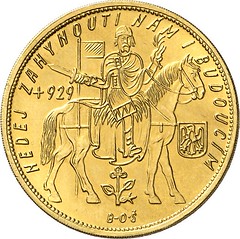
569 Czechoslovakia. 5 ducats 1938, Kremnica. Fb. 5. Mintage only 56 specimens. About mint state. Estimate: 10,000 euros. Hammer price: 110,000 euros.
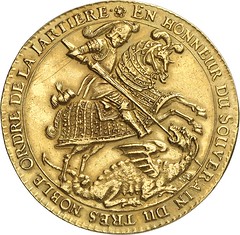
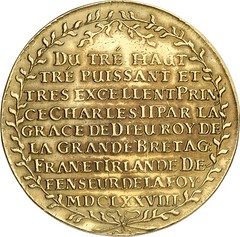
1114 Germany / Saxony. John George II, 1656-1680. 12 ducats 1678, Dresden, on the conferral of the Order of the Garter and the feast day of the Royal Order of St. George. Clauß-Kahnt – (see 528, 10 ducat piece there). Extremely rare. About extremely fine. Estimate: 10,000 euros. Hammer price: 26,000 euros.
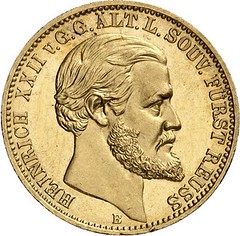
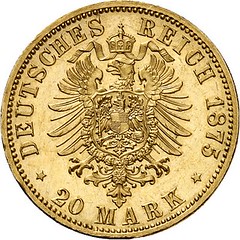
1265 German Empire. Reuss, Elder line. Henry XXII, 1859-1902. 20 mark 1875. Very rare. Estimate: 50,000 euros. Hammer price: 55,000 euros.
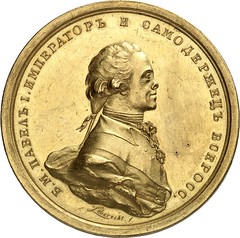

1762 Russia. Paul I, 1796-1801. Gold medal of 10 ducats n. y. (1797), by C. Leberecht, on the coronation in Moscow. Diakov 243.7. Extremely rare. Extremely fine. Estimate: 40,000 euros. Hammer price: 85,000 euros.
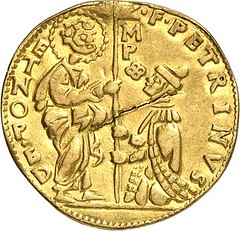
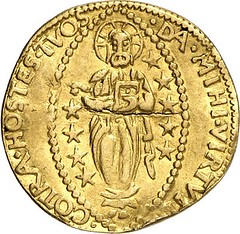
2818 Malta / Sovereign Order. Pierino del Ponte, 1534-1535. Zecchino n. d., Birgu or Fort St. Angelo. Fb. 3. 6 specimens are known to exist. Traces of mounting, very fine. Estimate: 3,000 euros. Hammer price: 16,000 euros.


2895 Malta / Sovereign Order. Ramon Perellos y Roccaful, 1697-1720. 2 zecchini n. d., Valetta. Fb. 20. Only two specimens available on the market. About very fine. Estimate: 10,000 euros. Hammer price: 24,000 euros.

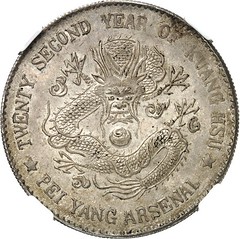
3164 China. Pei-Yang Province. 1 dollar year 22 (1896). Graded MS 62 by NGC. Dav. 186. Very rare. Extremely fine to mint state. Estimate: 15,000 euros. Hammer price: 140,000 euros.

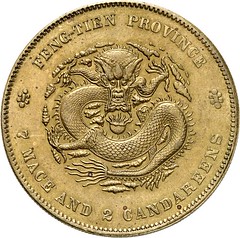
3275 China. Fengtien Province. 1 dollar n. d. (1897), brass pattern of Louis Schuler Company, Göppingen. The dies were produced by Otto Beh Company, Esslingen. Extremely rare. Extremely fine. Estimate: 5,000 euros. Hammer price: 38,000 euros.
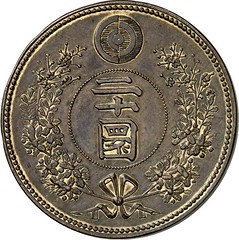

3313 Korea. Yi Hyong. 20 Warn year 495 (1886). Gilded pattern in copper. K./M. Pn 22. Very rare. About extremely fine. Estimate: 2,500 euros. Hammer price: 14,000 euros.
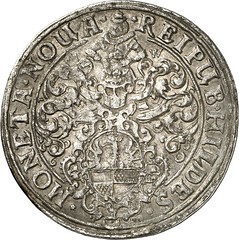
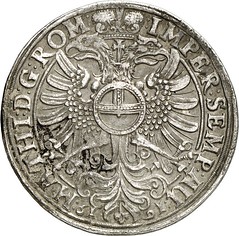
4163 Germany / Hildesheim. Reichsthaler 1619. Dav. -. Probably unique specimen. Very fine to extremely fine. Estimate: 4,000 euros. Hammer price: 26,000 euros.
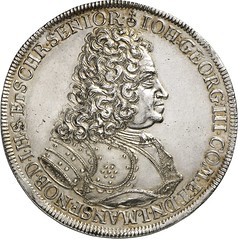
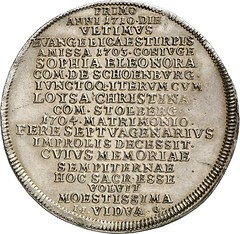
4276 Germany / Mansfeld. John George III, 1647-1710. Reichsthaler 1710, Eisleben, on his death. Dav. 2436. Very rare. Extremely fine. Estimate: 3,000 euros. Hammer price: 11,000 euros.

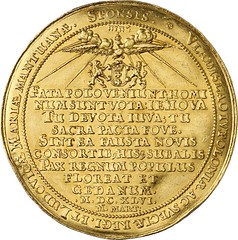
5027 Baums Collection. Poland. Danzig. Gold medal of 16 ducats 1646 by J. Höhn, on the second wedding of Wladyslaw IV with Marie Louise Gonzaga. H.-Cz. 1859var. (silver there). From auction sale Helbing 38 (1913), 3022. Extremely rare. About extremely fine. Estimate: 20,000 euros. Hammer price: 42,000 euros.
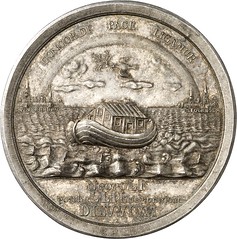
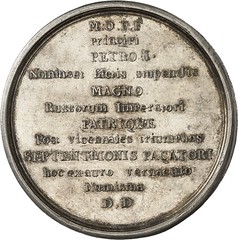
5465 Baums Collection. Russia. Peter I, 1682-1725. Silver medal 1721, unsigned (probably minted later, during the 19th cent.), on the Treaty of Nystad between Sweden and Russia. Diakov 57.6. Very rare. About mint state. Estimate: 2,500 euros. Hammer price: 11,000 euros.
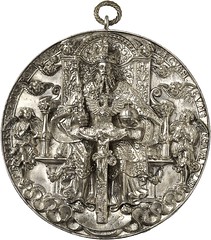

5936 Baums Collection. Saxony. Trinity medal. Cast silver medal 1544 by Hans Reinhart the Elder. Habich XX. 1. 1962. Extremely rare. Extremely fine. Estimate: 40,000 euros. Hammer price: 46,000 euros.
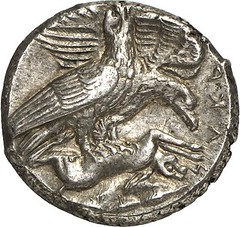
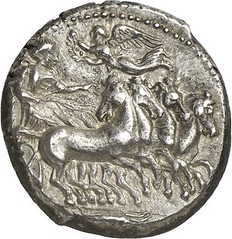
7050 Greeks / Akragas. Tetradrachm, c. 411 B. C. Franke / Hirmer pl. 61. 178 (same dies). Very rare. Extremely fine. Estimate: 25,000 euros. Hammer price: 32,000 euros.


7097 Greeks / Syracuse. Dekadrachm, after 405 v. Chr., signed by Euainetos. Gallatin C. XIV / R. VI. Obv. very fine. Rev. very fine to extremely fine. Estimate: 12,500 euros. Hammer price: 20,000 euros.

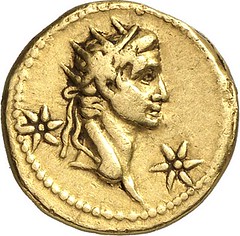
7448 Roman Imperial Times / Caligula, 37-41. Aureus, 37/8, Lugdunum. BMC 1. Slight traces of mounting(?). Very fine. Estimate: 10,000 euros. Hammer price: 26,000 euros.

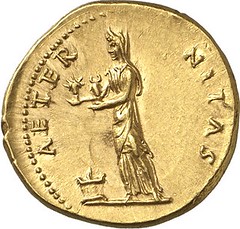
7477 Roman Imperial Times / Vespasian, 69-79. Aureus, 76. BMC 272. Extremely fine. Estimate: 15,000 euros. Hammer price: 34,000 euros.
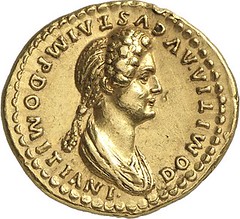
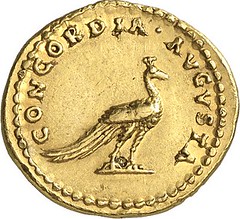
7491 Roman Imperial Times / Domitia, wife of Domitian. Aureus, 82/3 or later. BMC -. Extremely rare. Extremely fine. Estimate: 30,000 euros. Hammer price: 65,000 euros.


7540 Roman Imperial Times / Lucius Verus, 161-169. Aureus, 163/4. BMC 294. Very rare. Extremely fine to mint state. Estimate: 15,000 euros. Hammer price: 30,000 euros.
THE BOOK BAZARRE
REVIEW: GORNY & MOSCH SPRING 2014 SALES
More than a quarter of a million euros for four rarities from Czechoslovakia
Even though there were many remarkable results to be witnessed in the Gorny & Mosch auction sale conducted between 10 and 12 March 2014, one ought to be singled out: a set comprising four extremely rare gold coins from Czechoslovakia from 1938 that changed hands for 282,000 euros.
Every auction has its own surprises. With auction 221 of Gorny & Mosch it was lot 3498 with four gold coins, known as being rare, from the Republic of Czechoslovakia dating to 1938. The rather modest estimate had been 15,000 euros. The proud new owner, however, had to pay a bit more for these rarities. His invoice will amount to 282,000 euros*.
The reason for this high price was that the four pieces on offer are particularly scarce: only 186 specimens were being produced of the ducat, another 56 of the double ducat, 192 of the 5 ducat piece and 16 of the 10 ducat piece. It staggers the imagination to consider what such a set might have obtained if it had consisted of Russian or Chinese coins. Modern coins from Czechoslovakia rising to such a price range clearly indicate how intense the interest in numismatics has become in this country of the former Eastern bloc. This is by far the highest result achieved in the three spring auctions of the Munich auction house although other items obtained truly remarkable prices as well.
Auction sale 219 – High-quality ancient coins
Classical beauty is en vogue again. That is the impression one gets when looking at the results of auction sale 219 with high-quality ancient coins. Decent prices are being paid for the great artistic works even when their grading isn’t FDC.
A case in point is an incuse didrachm from Tarentum with the rider on the dolphin both on obverse and reverse. This piece whose provenance reaches back to 1987 had carried a pre-sale price tag amounting to 3,500 euros.
An art lover paid 13,000 euros for it in the end. The same sum was paid for an extremely fine didrachm from Croton with a slightly off-center obverse and a depiction of Hercules strangling the snakes on the reverse, which originally had been significantly underestimated with its 1,200 euros.
A third didrachm obtained the very result. It comes from Camarina and shows the Nymph on a swan on its obverse. The estimate of the attractive piece had been 2,500 euros.
Many collectors were anxious to see what the Archaic tetradrachm from Naxos might yield. Its reverse was very fine to extremely fine but its obverse exhibited traces of corrosion and hence could only be graded very fine. In the previous years, it had been rather difficult to sell such imperfect coins regardless of their good provenance – this coin goes back to the Ward Collection that was auctioned off in 1973. The modest estimate of 8,000 euros, on the other hand, took full effect. After having paid 47,000 euros, its new owner will be able to add this icon of Greek numismatics to his collection.
Comparatively modest appears the result of the tetradrachm of the city of Potideia located in Northern Greece. In all probability, this was the best preserved specimen featuring Poseidon Hippios on the reverse. However, the piece ‘only’ rose to 28,000 euros on a pre-sale estimate of 20,000 euros. The most expensive item of the sale of ancient coins – and its estimate had already anticipated that – became the octodrachm of the Edones tribe with the theft of Hermes on the obverse. It was sold for 88,000 euros.
Let’s have a look at the Romans, too. The trend for well-preserved Roman gold to obtain high prices continues unabatedly. Thus, an extremely fine aureus of Trajan with the façade of the Forum Traiani on the reverse brought 17,500 euros (10,000 euros), a good extremely fine aureus of Hadrian featuring the personification of Africa 47,000 euros (25,000 euros) and a perfect solidus of Aelia Verina 54,000 euros (25,000 euros).
Auction sale 220 – Ancient coins and multiple lots
To those who prefer the three-figure range to the five-figure prices when buying, auction sale 220 had plenty to offer. Many a piece was low in price.
That, however, didn’t hold true for the special collection of Postumus coins. There are many collectors in this field who recognize a rarity when they see one. Hence, a double sestertius from Trier with a galley on the reverse came with an estimate of 250 euros but obtained 1,650 euros in the end, a sestertius from Lyon with a special bust brought 1,400 euros after having been estimated at 300 euros, and an extremely rare sestertius with an adventus scene obtained 1,300 euros on an estimate of 200 euros.
Another result from the offer of literature that consisted of meaningfully assembled lots addressing individual topics deserves mention here as well. Lot 2123 comprising four volumes on the coinage of Northern Greece obtained a significantly higher price than the other lots (100 euros, 1,300 euros), even though – of perhaps because of – two of them being written in Bulgarian.
Auction sale 221 – Medieval and modern times
12 March was devoted to coins from the Middles Ages and modern times. A number of noteworthy results were achieved in this field, too. Examples are, from the section Germany, a reichsthaler 1606 from Eichstätt (VF-EF, 7,500 euros, 14,000 euros), a Hamburg portugalöser of 10 ducats from 1736 with a marvelous depiction of a ship (EF-FDC, 12,000 euros, 19,000 euros), the gold pattern of 5 ducats of the Nuremberg thaler 1698 on the Treaty of Ryswick (EF-FDC, 18,000 euros, 33,500 euros), the schmetterlingsthaler from Saxony of August the Strong (about FDC, 25,000 euros, 40,000 euros) and the mining thaler 1623 on the alleged Hungen yield of Solms-Braunfels (about FDC, 8,500 euros, 14,100 euros).
The small series of coins from Würzburg likewise was a good seller. The most expensive items were a 5 ducat piece from 1652 (EF-FDC, 25,000 euros, 37,600 euros) and a 5 ducat piece from 1702 (EF-FDC, 10,000 euros, 16,500 euros). It came as no surprise that the splendid imitations of ancient coins created by the best Renaissance die cutters found many friends and bidders. A medal on Antinoos, made around 1550 and having been estimated at 5,000 euros, depicting a wonderful temple façade on the reverse changed hands for 10,500 euros, just like the medal on Queen Artemisia created by Alessandro Cesati, nicknamed il Grecchetto, did.
The most expensive item of this small series, and deservedly so, was the marvelous medal on Lycurgus by Valerio Belli, called Vicentino. The extremely fine specimen with its fine dark patina rose from 10,000 euros to 20,500 euros. There was only one single order being offered in auction sale 221 but that one was highly coveted, a Pour le mérite with Oak Leaves conferred on Otto Ritter von Rauchenberger. The rare item with original accessories had been called out for 10,000 euros and found itself a new owner for 30,500 euros in the end.
Let us conclude this review with some results from the foreign countries: a speciestaler from Denmark about FDC from 1667 that had been called out for 7,500 euros but was sold for 13,000 euros. An extremely rare and extremely fine thaler of Vincenzo Gonzaga (1587-1612) from Mantua increased from 10,000 euros to 14,000 euros, while the even rarer and about FDC scudo of Napoleone Spinola from Ronco from 1669 with its estimate of 30,000 euros changed hands as late as 49,000 euros.
An extremely rare ducat from Riga from 1700 in extremely fine to FDC yielded 15,300 euros (10,000 euros) and a Russian 50 zlotych piece from 1829 for Poland obtained 17,600 euros (10,000 euros).
The results of the coins from Czechoslovakia have already been mentioned. There is only one thing to be added: a second set comprising of four gold coins on the reopening of the Kremnica Mines from 1934 came with an estimate of 15,000 euros but obtained 23,500 euros still in the end.
All results can be found on the internet at http://www.gmcoinart.de/online_katalog . If you are interested in the lots unsold please contact Gorny & Mosch, Giessener Münzhandlung, Maximiliansplatz 20, D-80333 Munich, phone +49 / (0)89 / 24 22 643-0, fax +49 / (0)89 / 22 85 513.
Consignments for the upcoming October auction sale 2014 are accepted as of now until 25 July 2014.
* All results include 17.5 % buyer’s premium, exclusive of VAT, and are slightly rounded.
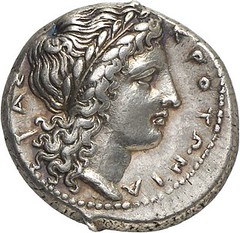
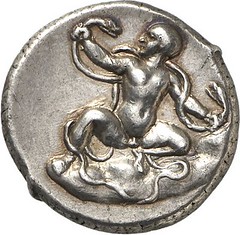
Lot 19: CROTON (Bruttium). Didrachm, c. 390-360 B. C. Extremely fine. Estimate: 1,200,- euros. Final price: 13,000,- euros
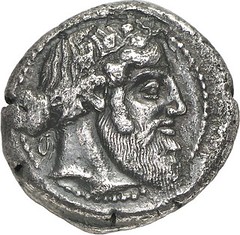
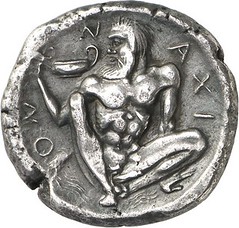
Lot 45: NAXOS (Sicily). Tetradrachm, c. 460 B. C. Ex Ward Coll. (Sotheby’s Zurich 1973), 176. Very rare. Slightly coarse surface. Very fine / very fine to extremely fine. Estimate: 8,000,- euros. Final price: 47,000,- euros
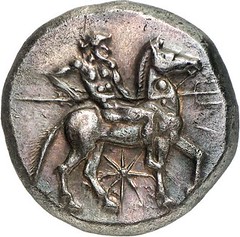
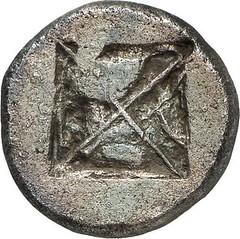
Lot 102: POTIDEIA (Macedonia). Tetradrachm, c. 500-480 B. C. Rare. One of the best preserved specimens. Very fine to extremely fine. Estimate: 20,000,- euros. Final price: 28,000,- euros
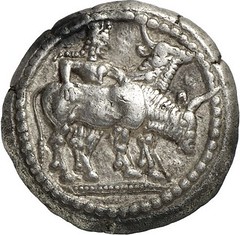

Lot 106: EDONES (Macedonia), Getas. Octodrachm, c. 479-465. Extremely rare variant. About extremely fine. Estimate: 75,000,- euros. Final price: 88,000,- euros
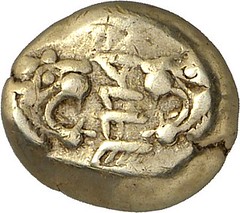

Lot 248: VALVEL (Lydia). Trite, around 650-610 B. C., Sardeis(?). Especially well centered specimen. Very rare. Very fine. Estimate: 3,000,- euros. Final price: 14,000,- euros
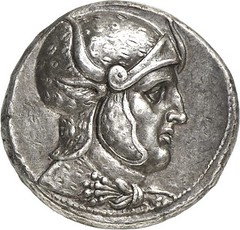

Lot 263: SELEUCUS I, 312-281 B. C. Tetradrachm, c. 305/4-295, Susa. Extremely fine. Estimate: 12,000,- euros. Final price: 17,500,- euros
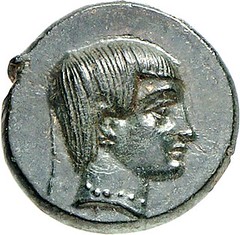

Lot 294: GAMERSES, Persian satrap of Lydia. Bronze, 1st half 4th cent. B. C. Extremely fine. Estimate: 300,- euros. Final price: 2,000,- euros
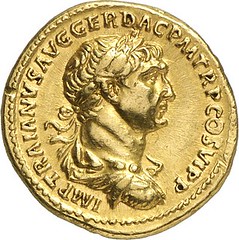

Lot 394: TRAJAN, 98-117. Aureus, 112-114. Rev. FORVM TRAIAN. Edge nick at the rim. Extremely fine. Estimate: 10,000,- euros. Final price: 17,500,- euros


Lot 403: HADRIAN, 117-138. Aureus, 134-138. Rev. AFRICA. Good extremely fine. Estimate: 25,000,- euros. Final price: 47,000,- euros

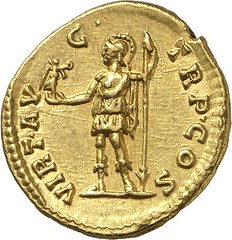
Lot 436: SEPTIMIUS SEVERUS, 193-211. Aureus, 193-194. Rev. Virtus l. Ex Huntington Coll. Extremely fine. Estimate: 20,000,- euros. Final price: 36,500,- euros
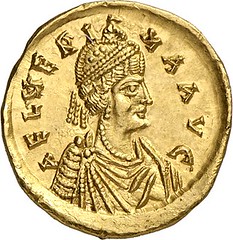
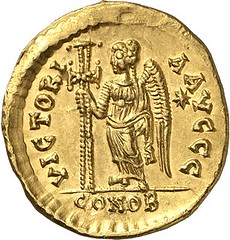
Lot 527: AELIA VERINA, 457-484. Solidus, 462-466. Extremely rare. Extremely fine. Estimate: 25,000,- euros. Final price: 54,000,- euros
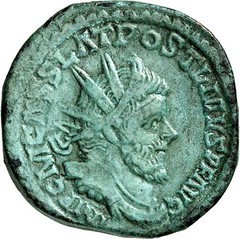

Lot 1759: POSTUMUS, 259-269. Double sestertius, 261, Trier. Light green patina. Very fine. Estimate: 250,- euros. Final price: 1,650,- euros
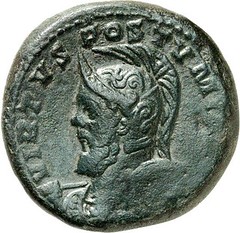
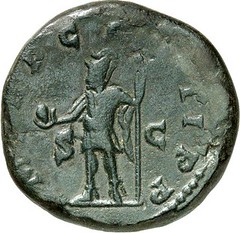
Lot 1766: POSTUMUS, 159-269. Sestertius, Lugdunum. Green patina. Very fine. Estimate: 300,- euros. Final price: 1,400,- euros
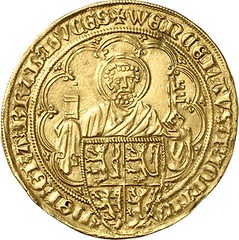

Lot 3109: NETHERLANDS – BRABANT. Johanna and Wenzel, 1355-1383. Pieter d’or. Rare. Extremely fine. Estimate: 1,750,- euros. Final price: 3,750 euros.
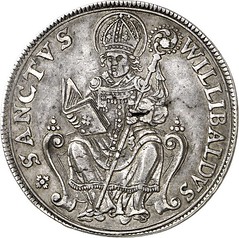

Lot 3201: GERMANY. Eichstätt. Reichsthaler 1606. Mintage: 999 specs. Very fine to extremely fine. Estimate: 7,500,- euros. Final price: 14,000,- euros

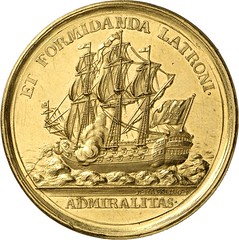
Lot 3210: GERMANY. Hamburg. Portugalöser of 10 ducats 1736. Very rare. Extremely fine to FDC. Estimate: 12,000,- euros. Final price: 19,000,- euros

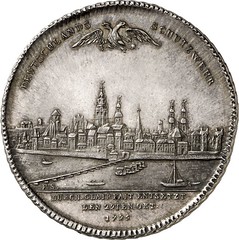
Lot 3249: GERMANY. Mainz. Friedrich Karl Josef von Erthal, 1774-1802. Konventionsthaler 1795, Mainz. Extremely rare. FDC. Estimate: 15,000,- euros. Final price: 20,000,- euros


Lot 3256: GERMANY. Nuremberg. Gold pattern of 5 ducats of the thaler 1698 on the Treaty of Ryswick. Very rare. Extremely fine to FDC. Estimate: 18,000,- euros. Final price: 33,500,- euros
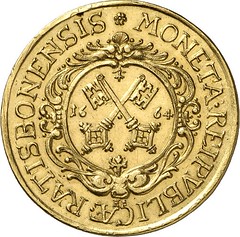
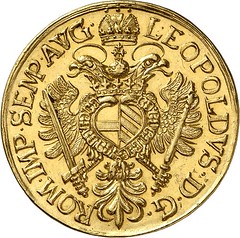
Lot 3266: GERMANY. Regensburg. 4 ducats 1664 HF. Extremely rare. About FDC. Estimate: 20,000,- euros. Final price: 26,000,- euros
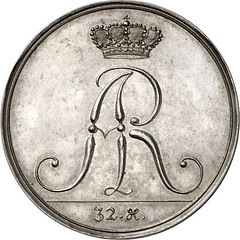

Lot 3277: GERMANY. Saxony. Frederick August I, 1694-1733. Schmetterlingstaler n. d. Extremely rare. About FDC. Estimate: 25,000,- euros. Final price: 40,000,- euros


Lot 3315: GERMANY. Würzburg. Johann Philipp I von Schönborn, 1642-1673. 5 ducats 1652, Nuremberg. Very rare. Extremely fine to FDC. Estimate: 25,000,- euros. Final price: 37,500,- euros

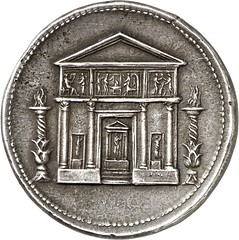
Lot 3375: MEDALS. Medal n. d. (c. 1550) on Antinoos. Extremely rare. Extremely fine. Estimate: 5,000,- euros. Final price: 10,500,- euros
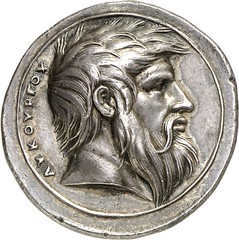
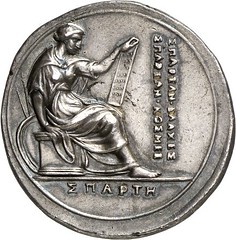
Lot 3380: MEDALS. Valerio Belli, called Vicentino, 1468-1546. Medal n. d. (c. 1539-1542) on Spartan king Lycurgus. From auction sale Astarte 8 (2001), 121. Extremely fine. Estimate: 10,000,- euros. Final price: 20,500,- euros
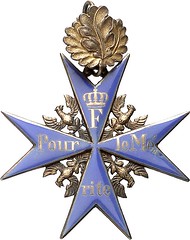
Lot 3391: ORDERS. Prussia. Pour le mérite, 1914-1918. Star of the Order with Ribbon and Oak Leaves for Otto Ritter von Rauchenberger. Very rare. With original accessories. From family property. Very fine to extremely fine. Estimate: 10,000,- euros. Final price: 30,500,- euros

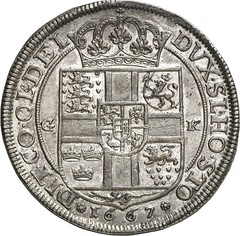
Lot 3417: DENMARK. Frederick III, 1648-1670. Speciesthaler 1667. Very rare. About FDC. Estimate: 7,500,- euros. Final price: 13,000,- euros
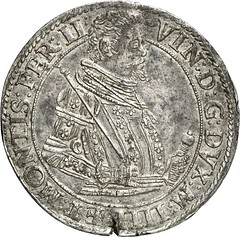
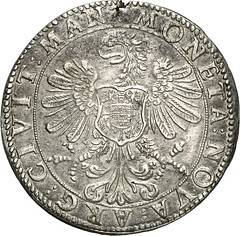
Lot 3437: ITALY. Mantua. Vincenzo I Gonzaga, 1587-1612. Thaler n. d., Mantua. Extremely rare. Extremely fine. Estimate: 10,000,- euros. Final price: 14,000,- euros

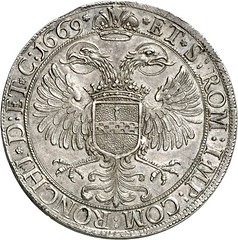
Lot 3439: ITALY. Ronco. Napoleone Spinola, 1647-1672. Scudo (spadino) 1669. Extremely rare. About FDC. Estimate: 30,000,- euros. Final price: 49,000,- euros

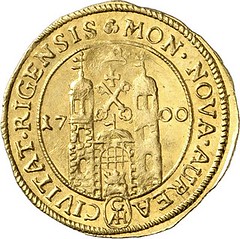
Lot 3455: LATVIA. Riga. Under Swedish dominion. Ducat 1700 GAH Riga. Extremely rare. Extremely fine to FDC. Estimate: 10,000,- euros. Final price: 15,300,- euros
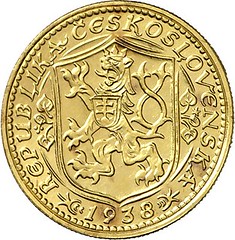
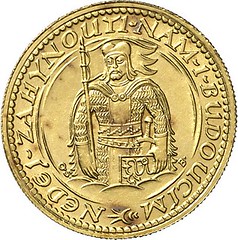
Lot 3498: CZECHOSLOVAKIA. Republic. Lot (4). 10, 5, 2, 1 ducat 1938. Extremely rare. Brilliant uncirculated. Estimate: 15,000,- euros. Final price: 282,000,- euros

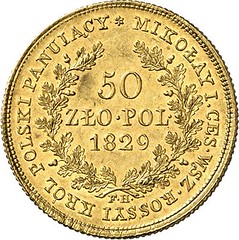
Lot 4053: RUSSIA. Nicholas I, 1825-1855 for Poland. 50 zlotych 1829, Warzawa. Rare. Fine scratches, extremely fine to FDC. Estimate: 10,000,- euros. Final price: 23,500,- euros
THE ARIELLE COLLECTION OF BRITISH COLONIAL COINS, PART TWO
The Arielle Collection Part Two
British Colonial Coins
The first day of Baldwin’s three-day May auction calendar will contain the second part of one of the most impressive British colonial coin collections to have ever been offered for sale by public auction. Part One of The Arielle Collection sold through Baldwin’s Coinex auctions in September 2013, where every one of the 818 lots sold for an exceptional sale total of £505,092.
Compiled by a collector who sought out only the finest specimens, the second and final part of the collection will comprise 980 lots. His impeccable collection includes many pattern and proof coins from British Guiana, British Honduras, British West Indies, Hong Kong, Straits Settlements, Ceylon, Cyprus, Fiji, the Ionian Island and New Zealand.
One of the most expensive coins in the sale, a 1905B uncirculated Straits Settlements Edward VII (1901-1910) Silver Proof 50-Cents from the Diana Collection. Issued shortly before coinage of the Straits Settlements was demonetised on 31st December 1952, is estimated to sell for £5,000 – 8,000. [Lot 487]
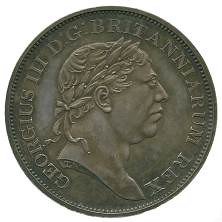

Many of the coins in the Arielle collection have a connection to the numismatic legend, Major F. Pridmore, and are fascinating pieces of numismatic history. Of note is an 1815 George III (1760-1820) Silver Pattern-Rix Dollar. Bearing a strong similarity to the 1821 coinage of George IV, Major Pridmore has made the argument that this is a proof and not a pattern. Generally, we have called coins made, but not issued for circulation, patterns, but Pridmore argues that 10,000 were supposed to have been issued, but as it never happened, what is the proper description for this coin? All known pieces were struck as proofs and this pushes the argument back to describing them as patterns, as they did not enter circulation. This well debated coin is estimated at £3,000 – 4,000. [Lot 283]
With an extremely good provenance an 1866 Victoria (1837-1901), Unique Bronze Pattern 1/26-Shilling from Jersey, is sure to cause a stir amongst collectors. The unique undated specimen has come from the collections of Pridmore, R. J. Ford and A.L.T. McCammon and was keenly fought over at the Pridmore sale in1981. Very used to being unchallenged in his quest to purchase the most expensive proofs and patterns, Richard Ford was aggrieved to have been bid up to £2,600 for this coin. He was however the successful purchaser, but in a strange twist of fate the under bidder, Anthony McCammon secured the coin for his collection some nine years later at exactly the same price. This very special coin is estimated at £2,000 – 3,000. [Lot 100]
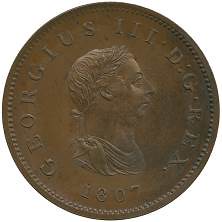

From more exotic locations, an ex Edward Roehrs collection 1807 George III (1760-1820) Restrike Bronzed Copper Proof Penny from the Bahamas, is a coin that has intrigued the cataloguer of this collection. Unlike all the 1806 coins which are struck on a coin die axis, this coin is struck on a medal die axis. It raises the question of when this coin was in fact created. There are differences on all three of the Bahamas Pennies in the collection, and nothing is conclusive, but a mystery yet to be solved. One of only three known to exist, it is estimated at £3,000 – 4,000. [Lot 723]
A stunning 1875H Victoria (1837-1901), Silver Specimen 20-Cents from Hong Kong is one of nine pieces found in the Heaton Mint, Birmingham, Archives, in various states of striking quality. The finest pieces of this date are the only 19th century Heaton coins that could be considered proofs as they were of the same quality as any proof from the Royal Mint. This exceptional coin is estimated to sell for £1,500 – 2,000. [Lot 652]
The auction will be held in the CIPFA Conference Centre, 3 Robert Street, London on Tuesday 6th May. Baldwin’s three-day auction schedule will include European coins from the collection of numismatist Ake Linden and The Hemisphere Collection of Gold Sovereigns. The catalogues for all three auctions will be available to view online at www.baldwin.com, and online biding with no additional premium is available through the services of www.the-saleroom.com.
NUMISMATIC HUMOR CONTEST RESULTS
On Tuesday I received a note from Steve Bishop with the results of the numismatic humor contest from the March Nummis Nova meeting. Tom Kays described the contest as follows:
Steve ordered up a side of numismatic humor. Numismatic humor is a tall order since fiscal jocularity and dry / dusty coin collectors are usually very distant relations. Coin collectors may be characters, but usually not comics. Jokes that only a coin collector would get was Steve’s objective, the more arcane the better.
Here are the compiled entries:
From Lenny Goldberg:
Oy! What a group of token Collectors? I think we have a collection of Tokenmen! I think I'll stop here.
From Mike Packard:
True (and funny) story for your consideration:
R Tettenhorst (Tett), whose fabulous collection of half cents was recently sold by the Goldbergs, once traded a very nice and rare half cent to Bill Weber for a coin Tett wanted. Bill traded the coin to Roger Cohen as a part of the Mega-Trade that allowed Roger to complete his collection of circulation strike half cent varieties. At the sale of Roger's collection in 1992, Tett bought the coin back. When asked why, Tett replied that it now had a much more impressive pedigree than when he first owned it.
From Dave Schenkman:
A man walks into an antique shop in New York City and sees a solid gold rat figurine in a case. He asks the price and is told it isn't for sale. When he ask why, the owner says "you don't want the rat; the rat will cause you big problems." The customer persists, and finally the shop owner say "all right, you can buy the rat, but I'm warning you, he's trouble. And, if you buy it I don't want you coming back here again." The man agrees, pays for the rat, and leaves.
After walking a few blocks he gets a funny feeling and looks behind him. There are about a dozen rats following him. A few blocks later he looks again and there are at least a hundred rats. He starts walking faster, and the number of rats keeps increasing. He finally panics and starts running. After about a mile he reaches the East River and, looking back, sees thousands of rats closing in on him. He takes the gold rat and throws it as far into the river as he can. The rats all follow it in and drown.
The man is amazed, and after calming down retraces his steps to the antique shop. The owner says, "I warned you the rat was trouble, and I told you not to come back." The customer says, "there's no problem, but I have to ask, would you happen to have a gold numismatist?"
From Steve Bishop:
Joe: Knock, knock.
John: Who's there?
Joe: Numismatist.
John: Geshundheit!
Q: Why did the numismatist become aroused when looking at three coins
graded very fine?
A: Because they were 35-25-35.
Here's a couple Steve found on the web:
"It's a token for the arcade games at Laser Sport Time!" Dan hissed.
"Uncle Alistair doesn't think so," Amy murmured. "He's a numismatist."
"He takes his clothes off in public?" Dan said."
Peter Lerangis, The Sword Thief
A couple decides to go to an old west tourist town as part of their
vacation. They see on the list of shows that there will be a public
execution scheduled for high noon and they go to check it out. Instead
of seeing a man on the gallows with a rope around his neck, they see
the "condemned" standing in the middle of the street and the sheriff
in front of him holding a shotgun. The sheriff loads a bunch of five
and ten cent pieces into the barrel of the shotgun, aims and fires
killing the man. The man turns to his wife and says "Boy, they really
nickel and dime you to death at these places".
Steven Preston
And a link to a really good story about Penny: http://www.bellaonline.com/articles/art34510.asp
Tom Kays writes:
I think there may be a tie. First is Mike Packard's true and funny story which best meets our stated aim of finding an esoteric and funny coin joke. I like it. But I also like the knock-knock joke which gets to the punch line sooner. I would call these two jokes tied for first place.
Steve Bishop writes:
Tom says it's a tie, but I am going to bow out and give the award to Mike Packard.
Well, Mike's Tettenhorst story gets my top vote, too. Congratulations - we have a winner! Steve created the following certificate for presentation to Mike. The coin pictured is the 1787 Connecticut Cent, Mailed Bust Left, Laughing.
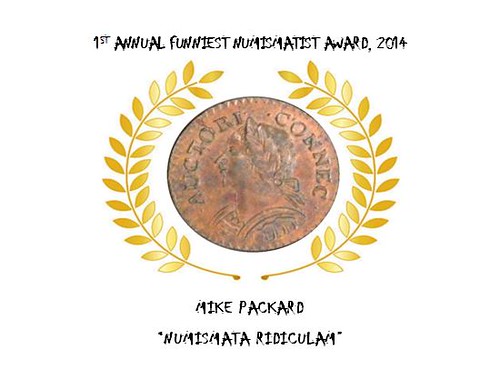
To read the earlier E-Sylum article, see: TOM KAYS' NUMISMATIC DIARY: MARCH 11, 2014 (www.coinbooks.org/esylum_v17n11a14.html)
WAYNE'S NUMISMATIC DIARY: MARCH 30, 2014
On Friday March 28th, 2014, I set aside the afternoon for numismatics and attended the Whitman Baltimore Spring Expo. On the drive there I spoke by phone (hands-free) with my old Pittsburgh friends Don Carlucci and Pat McBride. Pat and I have been working to settle the estate of the late numismatic book dealer John Burns.
I parked at the Pier V public garage and started walking toward the convention center. I was early enough that I could grab lunch at Chipotle without having to wait in the usual long line. After passing the National Aquarium and walking through Harborplace, I entered the convention center and made it to my first event right on time.
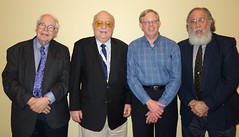 My first order of business was to meet Harvey Stack in person. He's a longtime email pen pal, but we'd crossed like ships in the night at multiple coin shows, and I didn't want to pass up the chance to finally meet him. Harvey and Larry Stack were to be on a panel with Dave Bowers. I entered the room and went straight to see David Lisot, who was getting his camera equipment set up to record the event. I gave him my condolences on the recent loss of his father. He thanked me for publishing his remembrance of his dad last week, and I told him more was on the way with this week's issue.
My first order of business was to meet Harvey Stack in person. He's a longtime email pen pal, but we'd crossed like ships in the night at multiple coin shows, and I didn't want to pass up the chance to finally meet him. Harvey and Larry Stack were to be on a panel with Dave Bowers. I entered the room and went straight to see David Lisot, who was getting his camera equipment set up to record the event. I gave him my condolences on the recent loss of his father. He thanked me for publishing his remembrance of his dad last week, and I told him more was on the way with this week's issue.
David walked me over to introduce me to Charles Morgan, a writer at CoinWeek whom I hadn't met yet in person either. The three of us made plans to talk later - David wanted to interview me in my role as editor of The E-Sylum.
I enjoyed the panel session. While others buttonholed Harvey afterwards, I spoke with Chris Karstadt and she arranged the new Stacks Bower's ad for tonight's issue. Dave Bowers introduced me to Mary Counts of Whitman Publications, another numismatic personality I hadn't met before. It was a busy day and I'd only just arrived. At last I was able to speak with Harvey Stack and afterwards we took a group photo. Dave Bowers emailed it to me Saturday. Thanks!
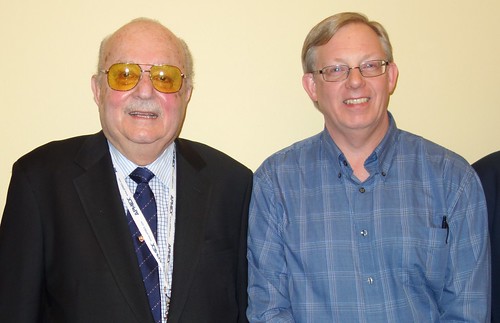
Harvey and Me
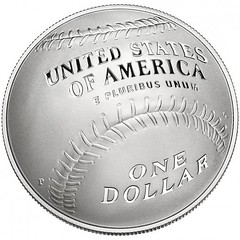 Before exiting the room I spoke with Dave, Chris and Mary. Dave had bought some of the new baseball commemorative coins and offered me one at cost. I bought an uncirculated silver example. As we walked out Mary and I talked about the Nobel prize medal that had just sold in the auction. In turn I had to tell her my story of how I bought Gen. Matthew Ridgeway's Congressional Gold Medal for John Ford,
Before exiting the room I spoke with Dave, Chris and Mary. Dave had bought some of the new baseball commemorative coins and offered me one at cost. I bought an uncirculated silver example. As we walked out Mary and I talked about the Nobel prize medal that had just sold in the auction. In turn I had to tell her my story of how I bought Gen. Matthew Ridgeway's Congressional Gold Medal for John Ford,
After signing in I entered the bourse area and walked over to the Whitman booth. Mary had warned me that Dennis Tucker was under the weather and probably wouldn't be on duty. I missed him, but was glad to see another friend - former Mint Director Ed Moy was signing copies of his new book on the gold and platinum eagle bullion coins. When he got a break we chatted a while. He favorably remembered his visit to Nummis Nova, my Northern Virginia numismatic social group, and we made plans to have him join us again soon when he completes his planned move back to the D.C. area from Seattle.
Next I hit the nearby CoinWeek booth to chat some more with writer Charles Morgan. We talked about The E-Sylum and recent articles in both of our publications. The weekly link to The E-Sylum from CoinWeek is likely responsible for several of our recent new subscribers. Welcome, everyone!
I had a number of other people I wanted to see, as well as the task of getting help and advice for disposing of John Burns' coins. Luckily one of the first people I ran into was Al Boulanger from Indiana. I'd known him for years since he'd been a regular dealer at the PAN shows in Pittsburgh. It turned out Al sold John a large collection of German Porcelain notgeld several years ago, so he was perfect for appraising John's extensive personal collection of porcelain. We talked about John for several minutes, and made plans to get together in May at PAN.
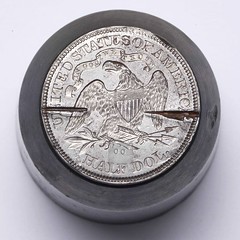 The rest of the day was a blur. I think my next stop was the NGC booth to see David Lange. After that was Charlie Davis' table. He and I talked about the Burns estate. Browsing at Charlie's table was David Sundman of Littleton Coin Company. We talked about his 1870 Carson City coin die. I'd missed his presentation at the Liberty Seated Collector's Club at 9am, but luckily the die was still on exhibit in a case at his table. I checked it out later, and it was great to see it in person. Dave's exhibit was very nicely done and I hope he brings it to future shows.
The rest of the day was a blur. I think my next stop was the NGC booth to see David Lange. After that was Charlie Davis' table. He and I talked about the Burns estate. Browsing at Charlie's table was David Sundman of Littleton Coin Company. We talked about his 1870 Carson City coin die. I'd missed his presentation at the Liberty Seated Collector's Club at 9am, but luckily the die was still on exhibit in a case at his table. I checked it out later, and it was great to see it in person. Dave's exhibit was very nicely done and I hope he brings it to future shows.
Others I visited with included Julian Leidman and Wayne Herndon. I also saw Blaine, Ted and Nancy Shiff at the Cybercoins booth. After trekking to the lobby to grab a beverage I settled in at John Kraljevich's table. He filled me in on his new married life, and I gave him an update on the Burns estate. Let's just say Burns was a packrat. He didn't like throwing things away. Pat McBride and his crew of volunteers had their work cut out for them. John's townhouse and five storage units were crammed with stuff. I was up there helping to sort through the numismatic literature the other weekend.
Tom Fort and Ed Krivoniak were elsewhere in the house when I took a break to use the upstairs bathroom. Somehow, the door got locked. And guess what - it wouldn't open no matter how much I jiggled and turned the knob. I told Kraljevich I began imagining the screeching violins from the Psycho soundtrack. I searched for a nail file or something to use to pry the bolts out of the hinges. Tom and Ed worked on the lock from the outside, but no luck. Ed went to get some tools. I jiggled the knob again, and this time it opened. Whew. Is John haunting us?
The most dramatic development occurred earlier this week, while I was back in Virginia. Pat had hired a locksmith to open the safe in John's basement. No combination had been found. The locksmith needed to study some schematics before drilling. But Ed wanted to try his hand at it, and Pat gave him free reign. "Here's a chair - have all the fun you want."
Ed was becoming obsessed. He hadn't slept much the night before, and had been dreaming of numbers. He had been fiddling with the lock for a couple hours by the time Pat got on the phone with me. Pat heard screaming in the basement and thought someone had gotten hurt. He ran downstairs. Turns out, Ed had managed to pop the safe open! Pat's phone was still on and I could hear him repeating "Holy Crap!" a half dozen times.
The helpers photographed the contents and Pat drove everything to a safe location for detailed inventorying. There'd been a running bet among the crew about what would be found in the safe. Would it be a Geraldo Moment? But Pat was certain we'd find coins, and he was right. The safe was stuffed to the gills, including boxes and boxes of coins.
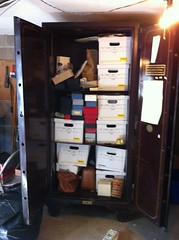

John's safe, with "The Cracker", Ed Krivoniak
I asked John Kraljevich and his bourse neighbor Tony Terranova about movie posters, another hobby of John Burns'. Both directed me to Heritage, even though we don't think there are any high-end items in the collection.
After parting with John K. I stopped to chat with Tony. I told him about a web site project I'm working on. Before I could even finish telling him about it he'd written a generous check to help with expenses. Thanks! I want to pick up where Harry Bass left off with his Numismatic Indexes Project (NIP), and Tony's contribution was in honor of Harry.
Next I found my way back to the CoinWeek table and before I knew what was happening David Lisot had me wired for sound and standing in front of his camera. He'd been wanting for years to interview me about The E-Sylum, so we finally did it. We thought it went well, and I'm curious to see the end product. Stay tuned!
Nearby their booth was the exhibit of gold coins from the 'Saddle Ridge' hoard. Included in the display were a couple of the cans in which the coins were found. Very neat!
I eventually made my way back to Charlie Davis' table. David Lisot came by and interviewed me again about John Burns. He did the same with Charlie and Del Parker. David will meld these into a tribute video for John.
Last time at the show I had made dinner plans and ended up being invited to two additional dinners. This time I didn't make prior plans and no other dinners materialized. Go figure. But that was OK - I was still stuffed from lunch, so I walked back to my car and headed home, giving Pat McBride an update along the drive. My wife was out to dinner with the rest of the family, and she brought home some take-out for me. I worked a bit on The E-Sylum before bedtime, but I was tired from a long day. It sure was fun to see and meet so many great numismatic friends. 'Til next time!
CHARLES MORGAN'S COINWEEK BALTIMORE SHOW REPORT
In the afternoon, the Smithsonian Institution held a special event concerning the construction and inauguration of a major new display for the National Numismatic Collection.
John Gray, Director of the National Museum of American History, and Jennifer Jones, Smithsonian Chair in charge of the numismatic collection, gave presentations about the ongoing renovations and fund-raising work ahead of the 2015 relaunch of the NNC public display.
The exhibit will feature a cladded (read:metallic) exterior and bank vault-door at the entrance, designed to show the valuable nature of the exhibit’s contents. Inside, two-sided viewing of notes and coins will line the walls. There will also be dozens of drawers that museum guests can open. The drawer exhibits will be rotated in and out on a regular basis.
The museum space will highlight important themes like culture, symbolism, and the projection of Liberty, prestige, and national strength. The Smithsonian will also focus on the evolution of money, from “primitive” forms (such as beads, shells, and Yap Stones), to specie and “advanced” forms like credit cards and virtual currency (such as Bitcoin).
The Smithsonian has also begun a massive archival project, the scope of which is unprecedented in numismatic history. Using medium format cameras, the museum is shooting thousands of sheets of proofs from the Bureau of Engraving and Printing at 800 dpi. The images are then cataloged and uploaded online, where volunteers provide item descriptions.
We were also told that the museum is close to hiring a new curator to oversee the National Numismatic Collection. The position has sat vacant since the passing of Richard G. Doty in June 2013. A decision between the final two candidates will be announced in April.
To read the complete article, see:
Whitman Expo Baltimore Coin Show Report: Part 1
(www.coinweek.com/featured-news/whitman-expo-baltimore-coin-show-report-part-1/)

CLUB PROMOTES SHOW WITH NATIONAL BANKNOTE SEARCH
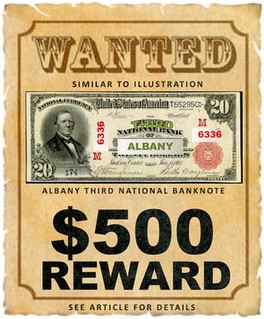 The Southwest Georgia Coin Club of Albany, in conjunction with the Albany Coin Show this weekend, is having a treasure hunt.
The Southwest Georgia Coin Club of Albany, in conjunction with the Albany Coin Show this weekend, is having a treasure hunt.
The coin collectors are looking for buried treasure that might exist in someone’s attic or closet. If you have what they are looking for, they will pay you a reward just for bringing it in to the show and allowing them to document its existence. Then, you get to take it back home.
Coin Club members hope to discover the existence of bank notes from some of the seven charter national banks that existed in Albany during its formative years. The reward for some of these bank notes range from $500 to $100. A $500 reward is being offered for a bank note from Third National Bank of Albany, charter No. 6336. Jeff Neal a member of the Albany Coin Club, said there are no known examples that exist from this particular bank.
“If you own one of these bills, it could be worth thousands of dollars,” Neal said. “If it does exist, there is a very good chance it is in Albany or the surrounding area.”
This particular bank note can be a $5, $10 or $20 note. If more than one banknote is presented, the reward will be given to the owner of the note in the best condition, as judged by coin club members.
Another rare banknote was issued by the Citizens National Bank of Albany, Charter No. 7777. Only one known example has been identified, Neal said. A $250 reward is offered for the best and most rare example of a large size of this banknote. This banknote would be a $5, $10, $20, $50 or $100 note. The final category with a reward is the best example of a small size Albany National banknote. The reward is $100. The banknote can be a $5, $10 or $20 banknote.
Neal said the rewards will be paid if the specific notes are presented. He said the project is not a solicitation to buy the banknote, but is an attempt to locate and preserve a historical treasure.
Winners will be announced at the end of the coin show, which will be conducted Saturday and Sunday at Knights of Columbus on Gillionville Road. Currency dealers and coin club members are not eligible for the reward.
To read the complete article, see: Rewards offered for rare bank notes from former Albany banks (www.albanyherald.com/news/2014/mar/23/rewards-offered-for-rare-bank-notes-from-former/)
THE TOP FIVE MOST NOTORIOUS MINT ROBBERIES
While there have been many robbery attempts at the United States Mint, most would-be thieves don’t make it out the door with the money. Here are the stories of five robberies that were at least initially successful— and what happened to the stolen money.
1. The Denver Mint Robbery
On the afternoon of December 18, 1922, five men stormed a Federal Reserve Bank delivery truck outside the U.S. Mint in Colorado. A black Buick screamed up to the curb and out jumped several gunmen who grabbed nearly $200,000 in currency that was being loaded onto the truck. U.S. Mint guards rushed to the scene, but the gang had already made their getaway. No one was ever charged with the robbery, despite Denver Police Chief A.T. Clark’s announcement 12 years later that the robbery team had been identified. The suspects that were identified were already in prison on unrelated charges or had died.
2. The Philadelphia Mint Gold Bar Robbery
In 1893, Henry S. Cochran, a weighing clerk at the Philadelphia Mint, was found to have embezzled $134,000 in gold bars from the mint vault over a period of approximately 10 years. Cochran, a 40-year government employee, pusheda bent wire through one of the small holes in the iron-latticed vault door. He used the wire to knock the topmost gold bar from a stack. He would then push the bar close to the door, which had a rusty hinge that allowed him to takethe gold from the vault. After questioning, Cochran confessed,police recovered $107,000 in gold bullion from his home and from a cache in the mint’s ventilation system.
3. The Philadelphia Mint Error Coins Robbery
William Gray, a retired 26-year veteran of the Philadelphia police department, had worked at the Philadelphia Mint since 1996. In 2011, he admitted to stealing $2.4 million worth of $1 presidential coins that were missing the edge lettering. He knew these nearly 32,000 “error coins” would be valuable and so he sold them to a California coin dealer. Gray pleaded guilty and was sentenced to 36 months in a federal penitentiary. He also had to forfeit most of his property and homes to pay back the government.
4. The San Francisco Mint Double Eagle Robbery
Walter Dimmick began working at the San Francisco Mint in 1898. By 1901 he was trusted with the keys to the vaults. That is, until an audit revealed that six bags of $20 Double Eagles worth $30,000 were missing. Despite a lack of hard evidence, suspicion fell upon Dimmick. At trial, Dimmick was found guilty and sentence to nine years in prison. The coins were never found. Recently, however, some have wondered whether the coins discovered in the Saddle Ridge Hoard were the ones the Dimmick had stolen from the mint. However, United States Mint representative Adam Stump told CNN, "We do not have any information linking the Saddle Ridge Hoard coins to any thefts at any United States Mint facility.” And so the mystery lives on.
5. The Perth Mint Swindle
Mint robberies don’t just happen in the United States. Perhaps the most famous heist from a mint occurred on June 22, 1982, when 49 gold bars weighing nearly 150 pounds were stolen from the Perth Mint in Western Australia. At today’s gold prices, the haul would be worth more than three million dollars. Three brothers — Ray, Peter and Brian Mickelburg — were convicted and sentenced to jail. However, all three convictions were overturned in 2004 — and the crime remains unsolved to this day.
To read the complete article, see: The Top Five Most Notorious Mint Robberies (www.kgw.com/marketplace/GoldCoins/The-Top-Five-Most-Notorious-Mint-Robberies-252008921.html)
TOURING THE DENVER MINT
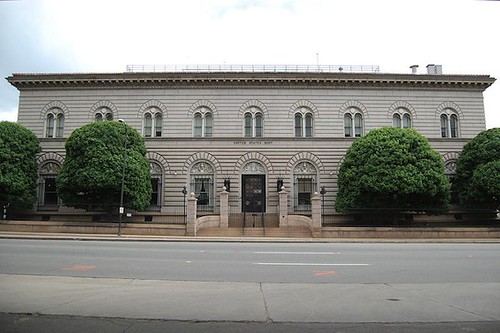
Money's sort of cool, right? There are just four United States mints in operation today, located in Philadelphia, San Francisco, West Point and, yup, sunny Denver. True, the Denver Mint might not have the raw sex appeal of, say, the Children's Museum, but the historic building is rightly treasured for being one of Colorado's oldest institutions and for its listing on the National Historic Register. What Coloradans may not know, though, is that this stately facility offers free daily public tours that'll amuse preschoolers, adolescents -- maybe even fickle teens, too.
The Denver Mint has a rich history that begins in 1858, the year gold was discovered in Colorado and hundreds of merchants migrated westward. A year later, Denver was founded, and then in 1863, the federal government established a mint facility in town. For its first 46 years of operation, the mint was a smallish and unassuming assay office in the Clark, Gruber and Company Bank Building, where local miners brought in things like gold dust and nuggets to be melted down and cast into bars.
But, by 1895, the facility was bringing in over $5.6 million in gold and silver deposits annually and so a new building was constructed at the location, this one much more grandiose than the first and inspired by a Florentine palace. Architect James Knox Taylor drew on Gothic Renaissance elements and, over a century before the "Buy Local" movement began, he chose granite from Arkins, Colorado for the building's stone facing. The grand hallway -- adorned with one-of-a-kind chandeliers and hand-stenciled ceiling artwork surrounded by gray- veined white-and-red marble -- is a marvel.
Guided 45-minute-long tours are free and run every ninety minutes, from 8:30 a.m. to 3:30 p.m. Mondays through Thursdays. Technically, these tours are recommended for children 7 and up, but, according to Jennifer DeBroekert in the mint's Office of Public Affairs, the tour guides make the experience memorable and fun for everyone.
During a typical tour, you'll get a bird's eye view of the production floor, complete with coining presses that strike over 750 coins a minute. Aside from watching the minting of coins and checking out real-live gold vaults, families can also sneak a peek at rare artifacts -- some of which date to the late 1700s and America's founding fathers.
To read the complete article, see: Child's Play: It's two for the money at the Denver Min (http://blogs.westword.com/showandtell/2014/03/denver_mint.php)

IRS: BITCOIN IS PROPERTY, NOT CURRENCY
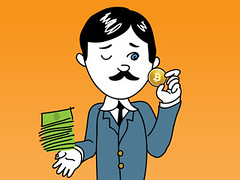 The IRS has officially stated that bitcoin is a property – similar to any other valuable commodity – rather than a currency. What does this mean? Not much. In short, if you pay someone in bitcoin – in the same way you could pay them in gold – the wages are taxed accordingly. It is also not considered legal tender but a capital asset.
The IRS has officially stated that bitcoin is a property – similar to any other valuable commodity – rather than a currency. What does this mean? Not much. In short, if you pay someone in bitcoin – in the same way you could pay them in gold – the wages are taxed accordingly. It is also not considered legal tender but a capital asset.
The key line is here: “A payment made using virtual currency is subject to information reporting to the same extent as any other payment made in property.”
We will have more on this ruling as we approach tax lawyers and accountants who may have to soon deal with a new cohort of the “bitcoin rich.”
To read the complete article, see: IRS Rules Bitcoin Is Property, Not Currency (techcrunch.com/2014/03/25/irs-rules-bitcoin-is-property-not-currency/)
The good news is that the IRS issued the first major ruling clarifying the tax treatment for bitcoin and presumably all crypto currencies. The long awaited guidance makes clear that for individuals, bitcoin will be treated like property, no different than gold or stocks. If held less than a year before being sold or used, the gain will be taxed at ordinary income tax rates. If held more than a year, the gain will be taxed at 23.8%. If sold or used at a loss, taxpayers can offset their future capital gains or up to $3,000 a year from ordinary income. This is a big benefit to those who made a bundle investing in bitcoin.
The bad news is that the IRS ruling is an obstacle to bitcoin’s growth as a currency. Complying with the IRS now means a lot of paperwork keeping track of all of a person’s transactions, even common everyday purchases (though I’m sure someone will eventually develop an app for this). Then for each transaction, a person has to figure out what the value of the bitcoin used when first acquired and subtract it from that day’s value of that bitcoin, can keep track of the capital gains or losses for the person’s individual tax return.
But that is not all. Bitcoin users will have to report to the IRS any transaction value above $600, and every instance where it is used for rent, salaries, wages, premiums, annuities, and compensation.
This will have a near term chilling effect on bitcoin’s use for retail purchases. Buying your morning latte is now a taxable event. However, I’m sure someone will eventually write an app to make the paperwork easy.
Finally, all this takes effect immediately and applies to all past transactions. Individuals can apply for relief on those past transactions if they can show “reasonable cause” for why they underpaid or not paid their taxes on bitcoin transactions. Seems to me that having no IRS guidance until now is a pretty good reason.
To read the complete article, see: CONSEQUENCES OF BITCOIN CLASSIFIED AS PROPERTY (edmoy.com/consequences-of-bitcoin-classified-as-property/)
BYZANTINE-ERA GOLD COINS FOUND IN LUXOR
 A collection of 29 golden coins from the Byzantine era has been found on Wednesday at Draa Abul Naga on Luxor's west bank.
A collection of 29 golden coins from the Byzantine era has been found on Wednesday at Draa Abul Naga on Luxor's west bank.
During a routine excavation carried out inside a tomb at an ancient Egyptian necropolis in the Deir Beikhit area of Draa Abul Naga, German excavators unearthed the collection of golden coins.
Antiquities Minister Mohamed Ibrahim said the coins were found wrapped in linen inside a hole found on one of the tomb's decorative columns.
Early studies, he went on, reveal the coins date from the fifth and sixth centuries AD.
To read the complete article, see: Byzantine-era gold coins found in Luxor (english.ahram.org.eg/NewsContent/9/40/97597/Heritage/Ancient-Egypt/Byzantineera-gold-coins-found-in-Luxor.aspx)
SOME RECENT COIN DESIGNS: MARCH 30, 2014
Poland 2 Zloty on Jan Karski

5 Ukrainian Hryvnia on 75 Zaporozhye Region
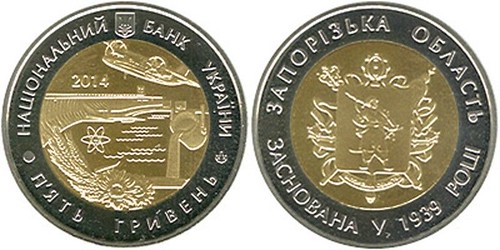
2 Ukrainian Hryvnia on Owen Lambs
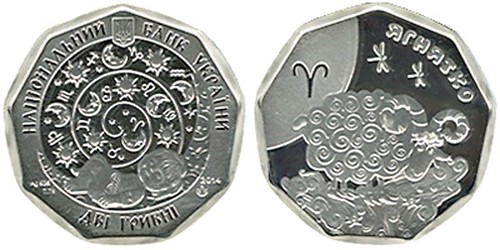
Malta 5 Euro Coin
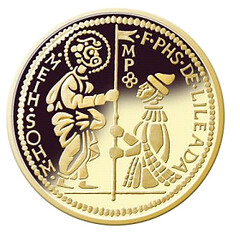
The Central Bank of Malta has issued a €5 gold coin depicting the zecchino. The zecchino gold coin was first minted in Venice in 1284 and derived its name from the Venetian mint which was known as the zecca. The coin, which weighed 3.5 grams, was of almost pure gold content.
Ukraine has bigger problems to worry about, but these coins look atrocious to me. Much, much too busy - too many things crowded into the small space.
The Malta coin is interesting, and I'm on the fence about it. I think some will love it and many others will hate it. But it's a novel approach to forming figures.
-Editor
FEATURED WEB SITE: CGB.FR ARCHIVE
This week's Featured Web Site is the archive section of the cgb.fr site. Cgb.fr is the coin company founded by the late Michel Prieur. Some 300,000 items are illustrated with full descriptions.

www.cgb.fr/archive.html
